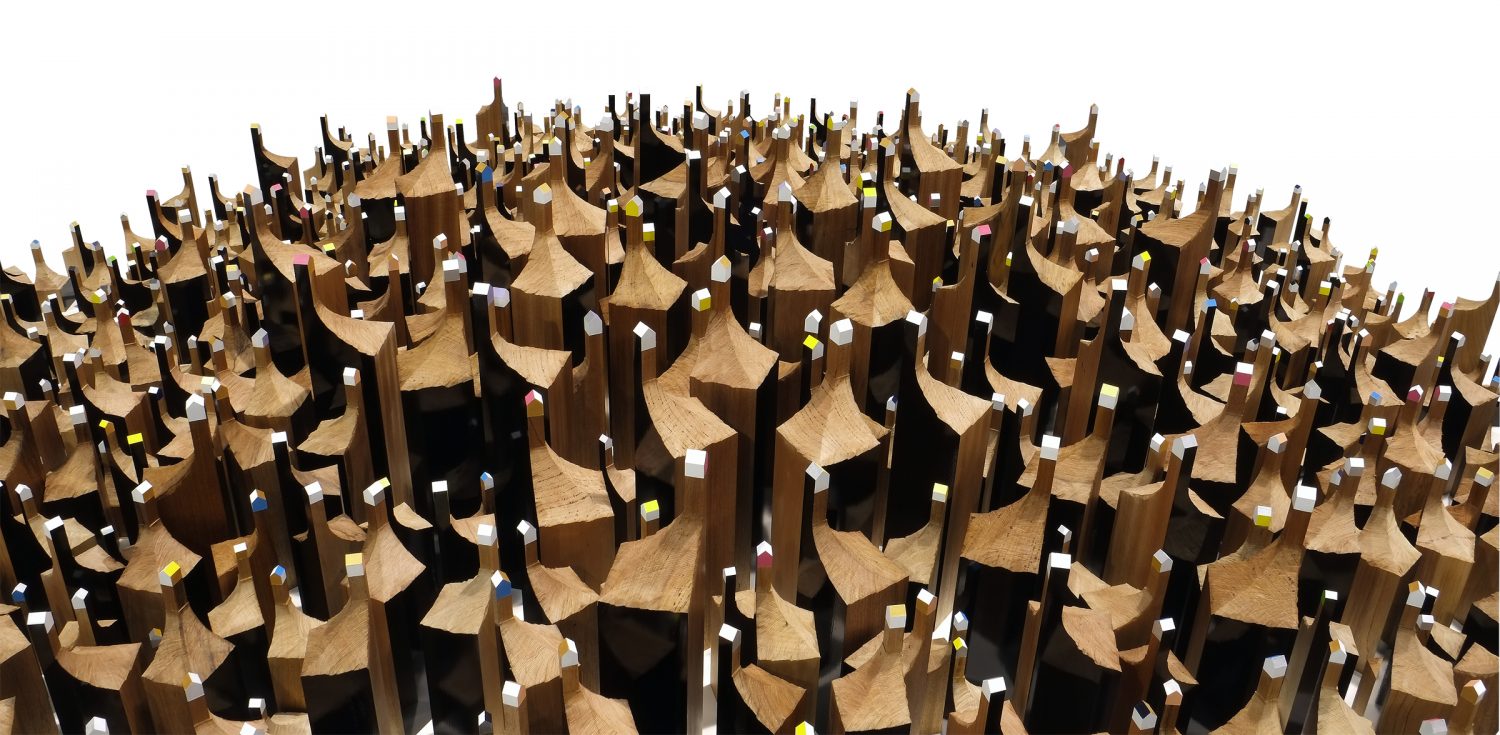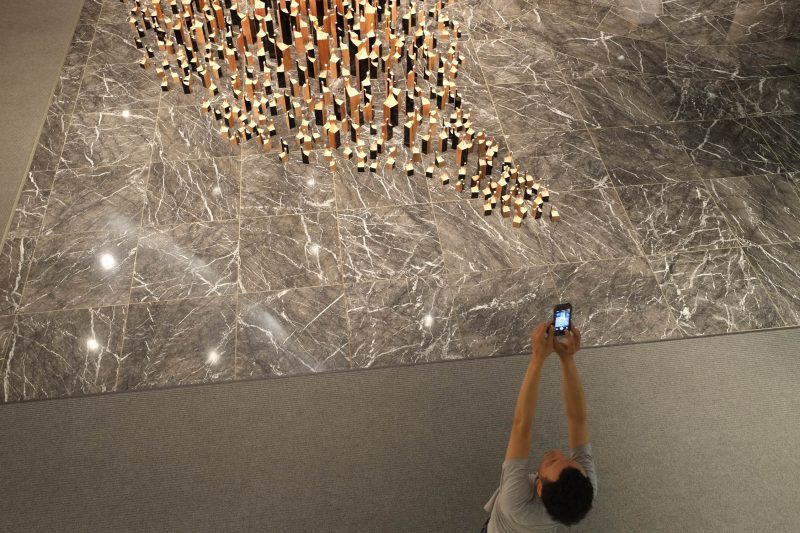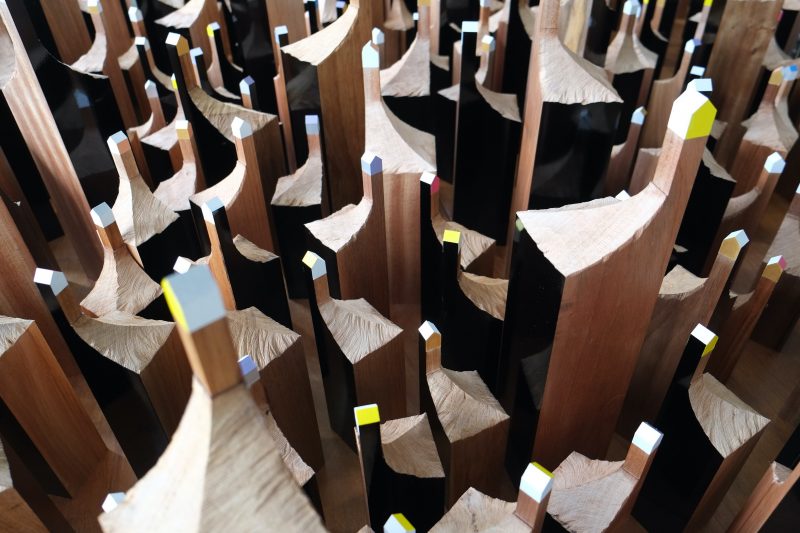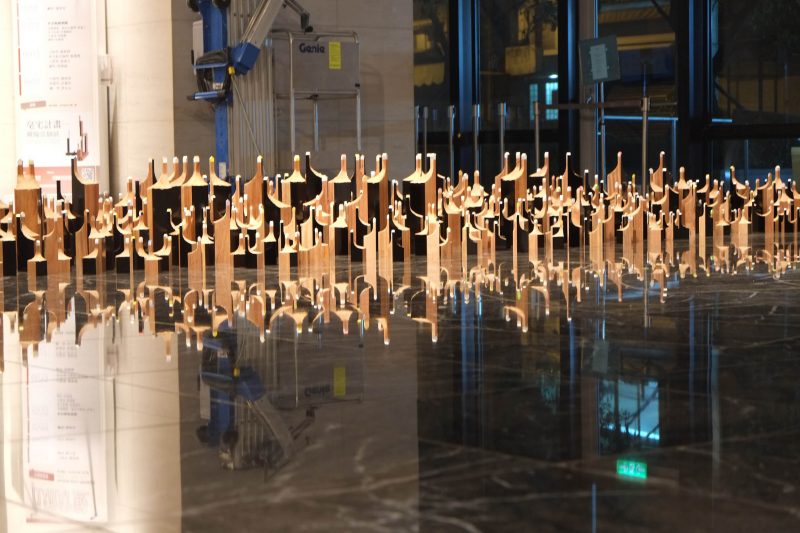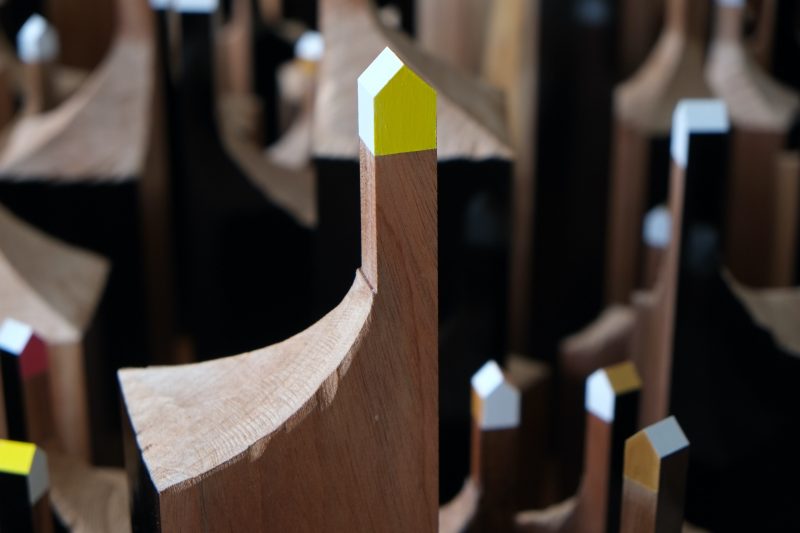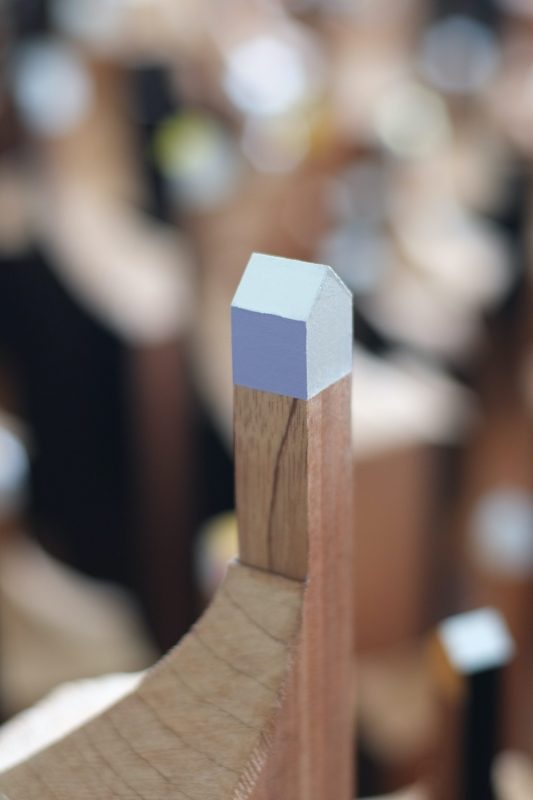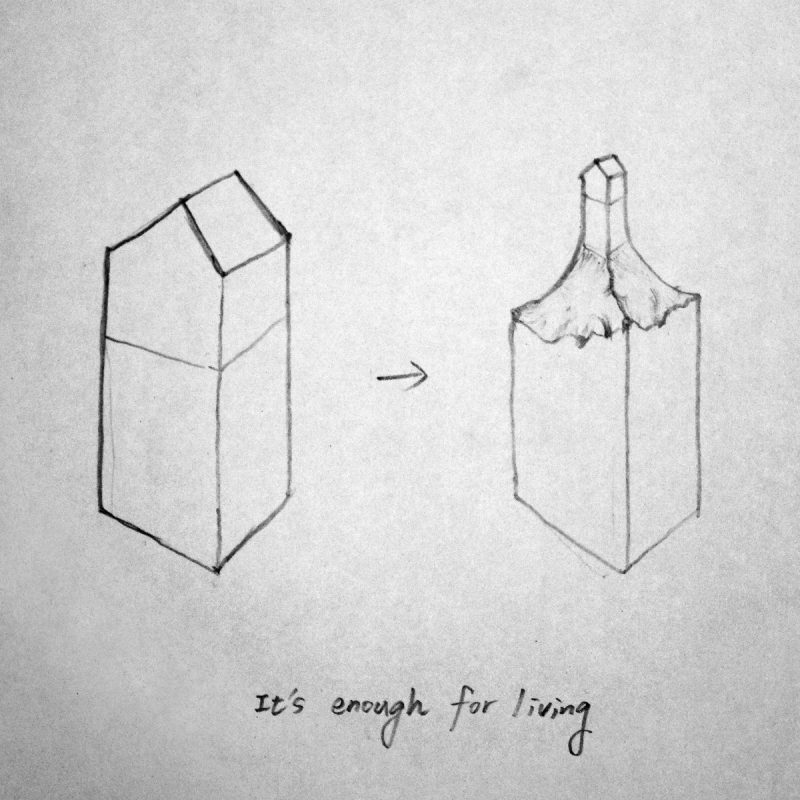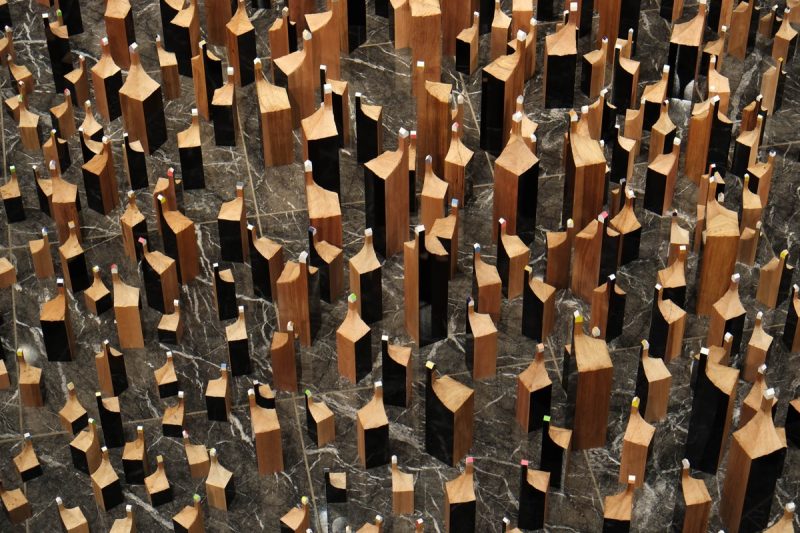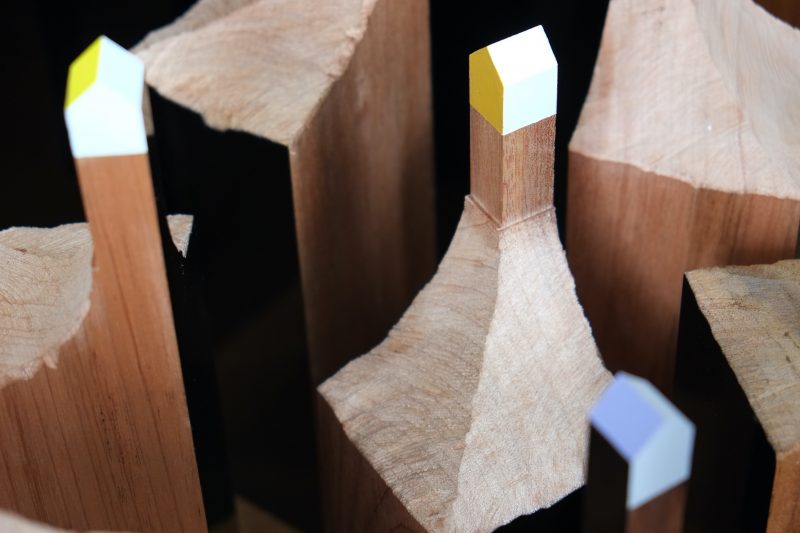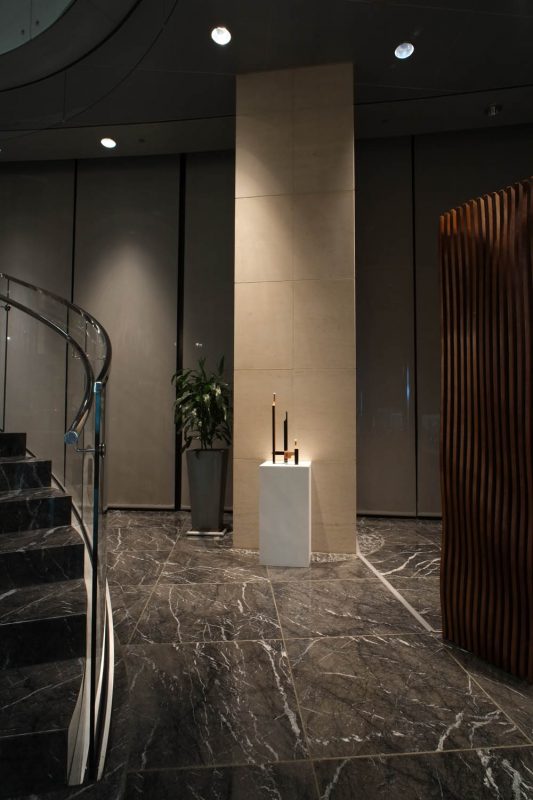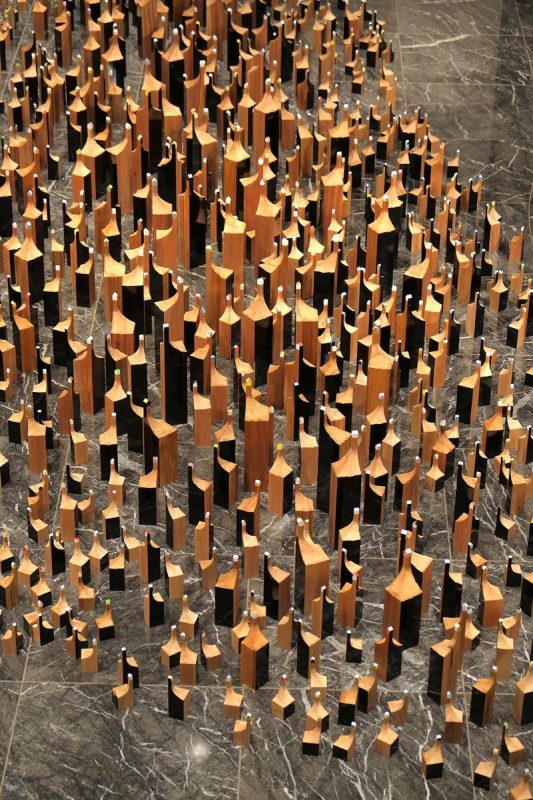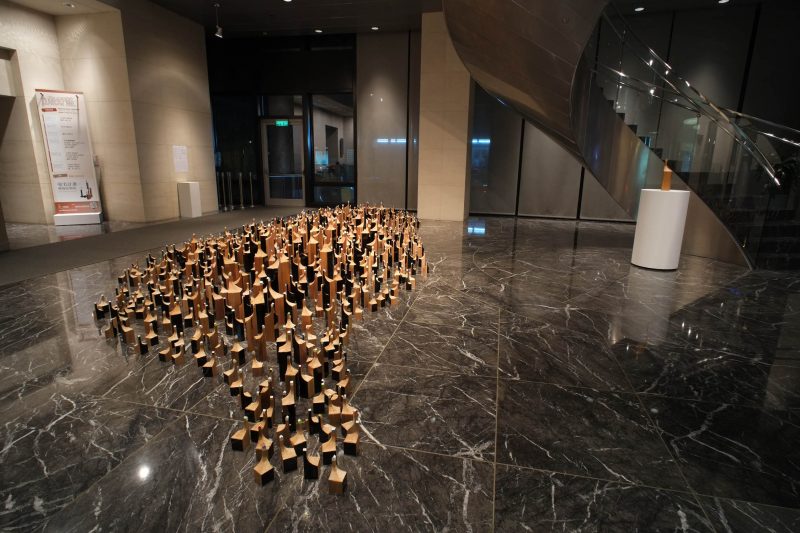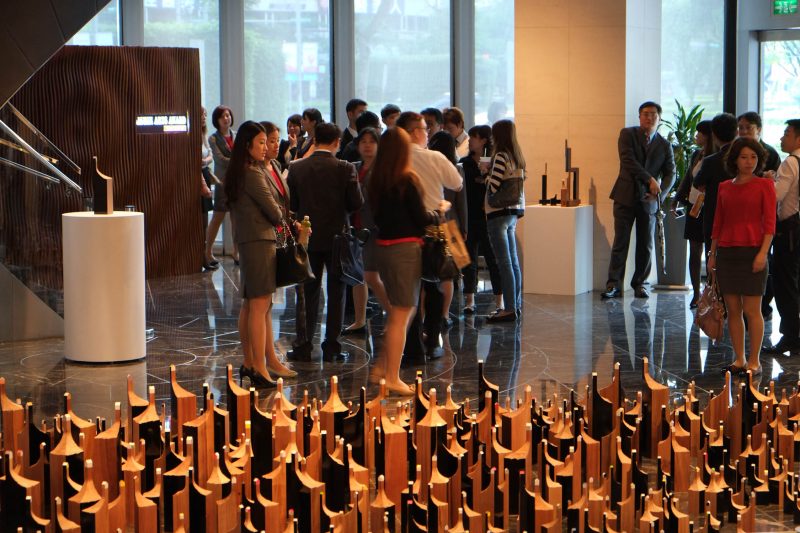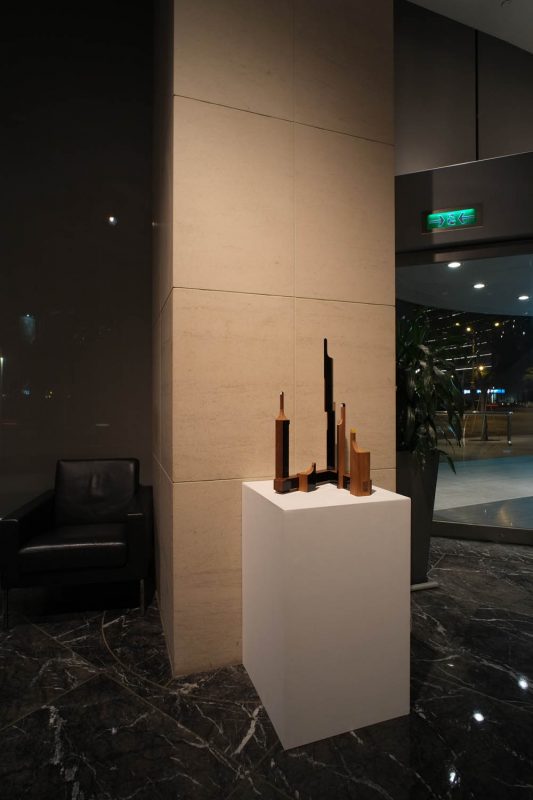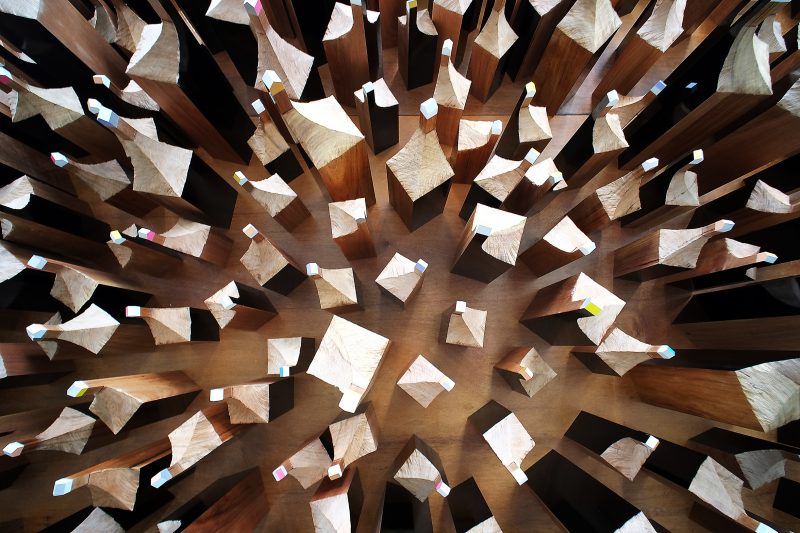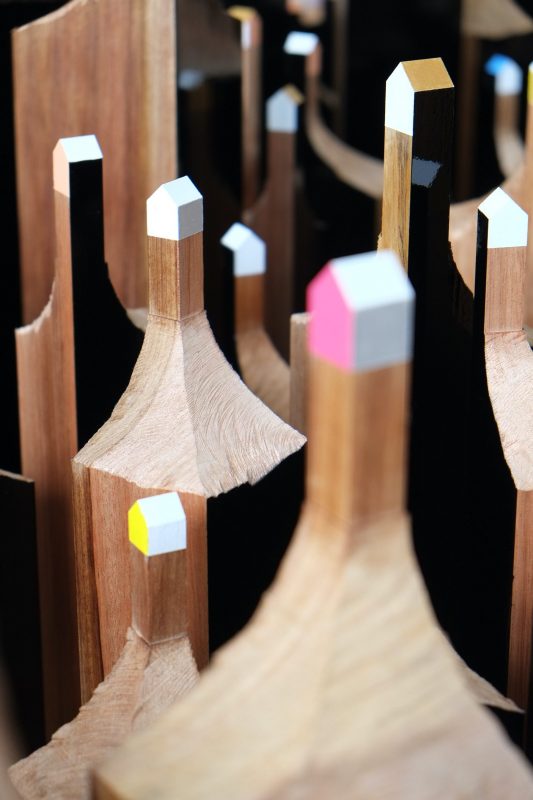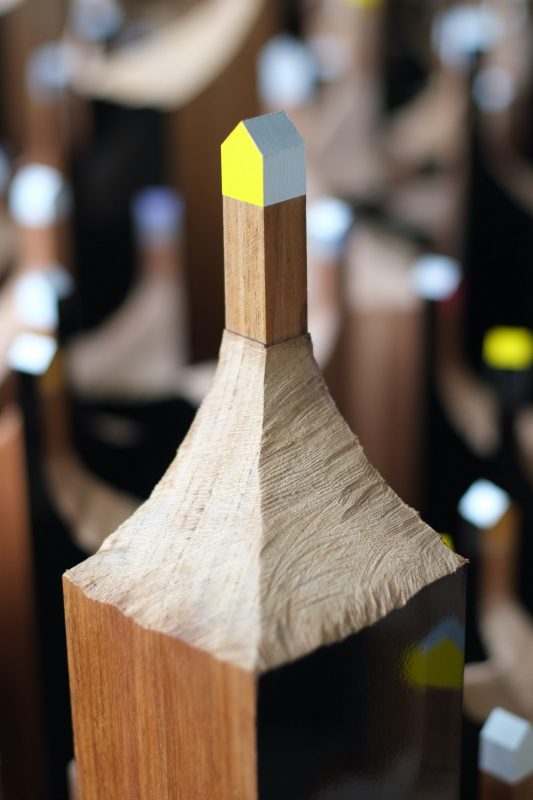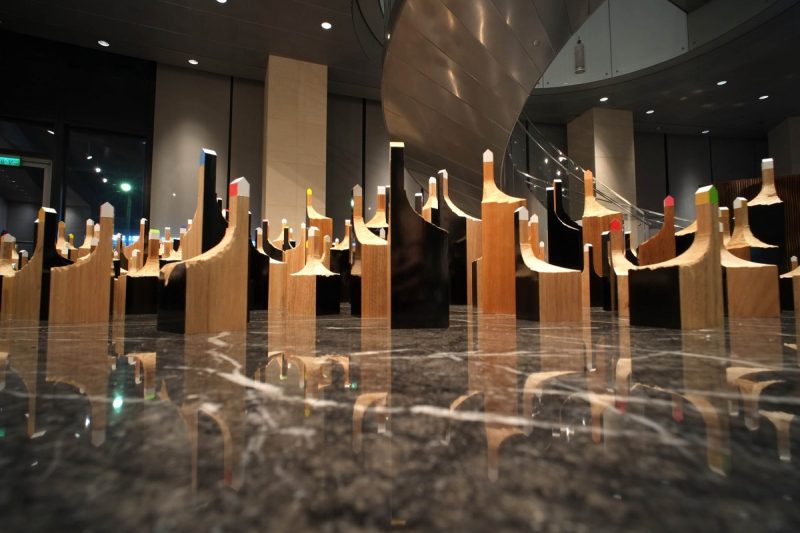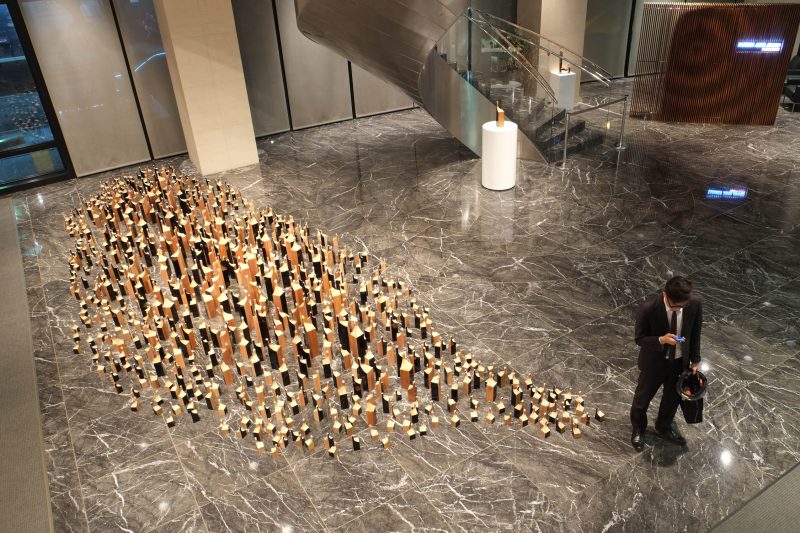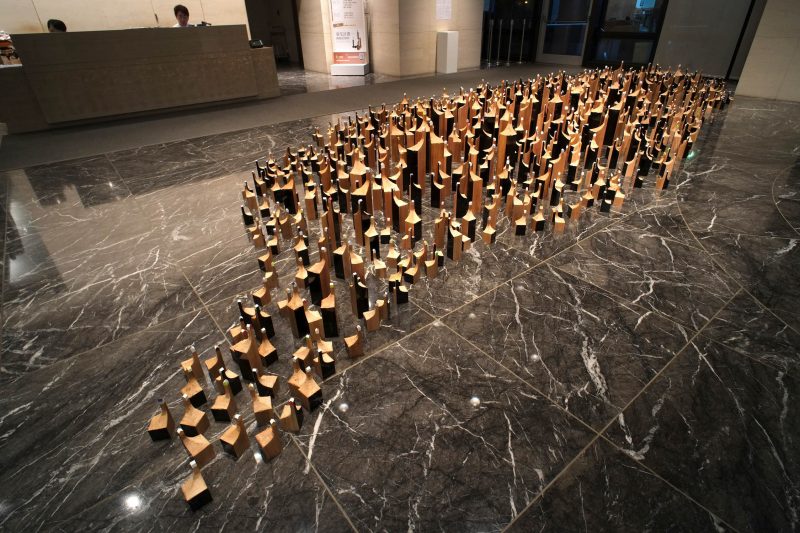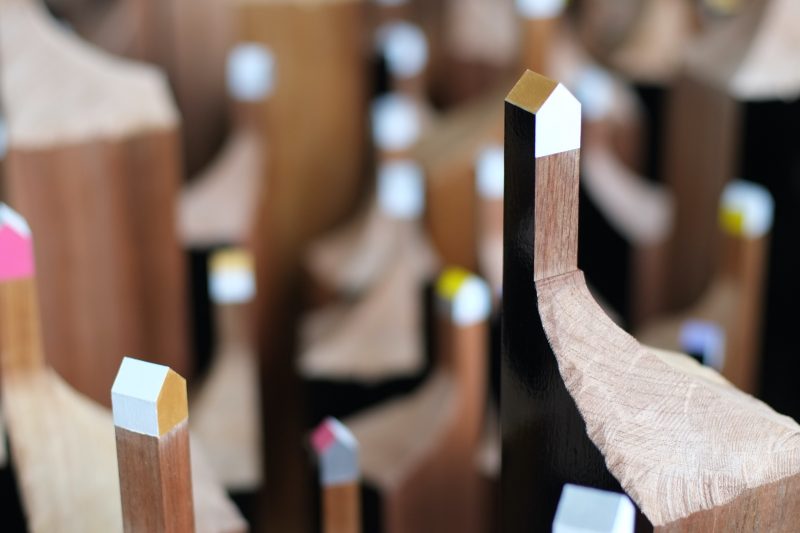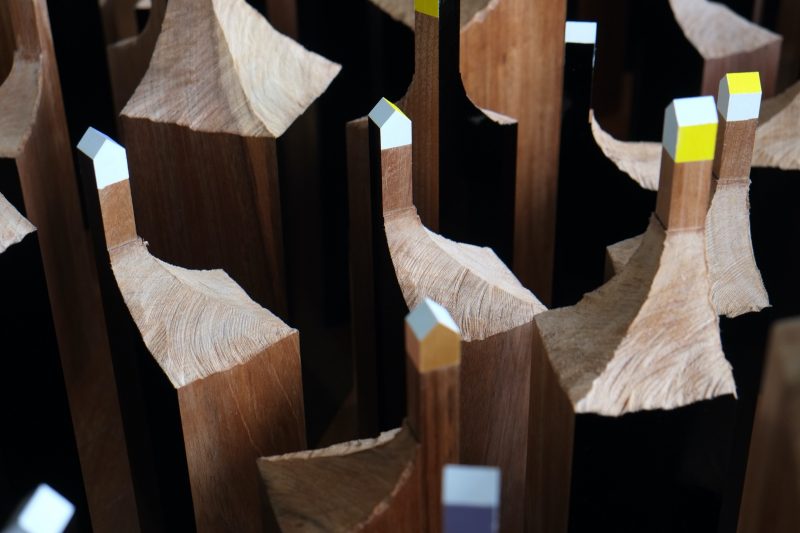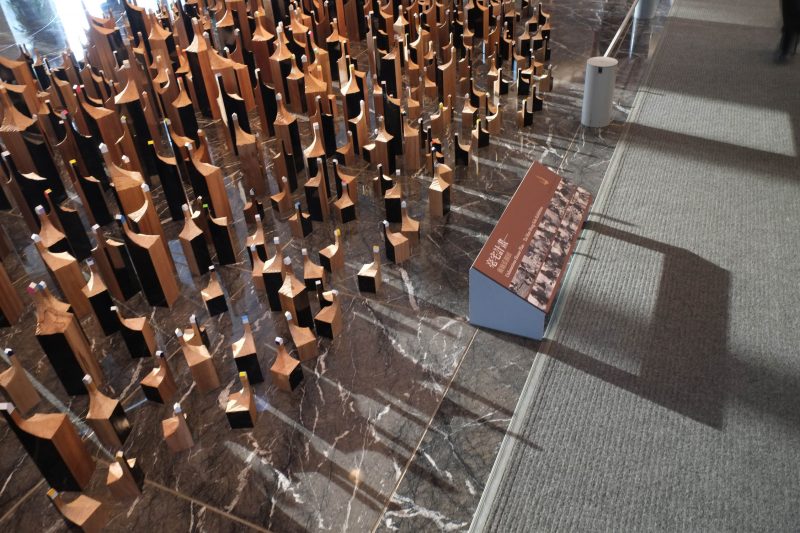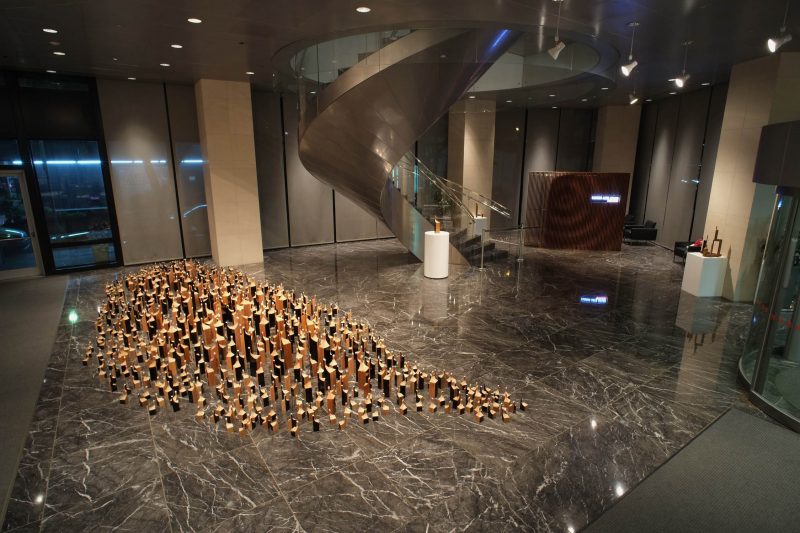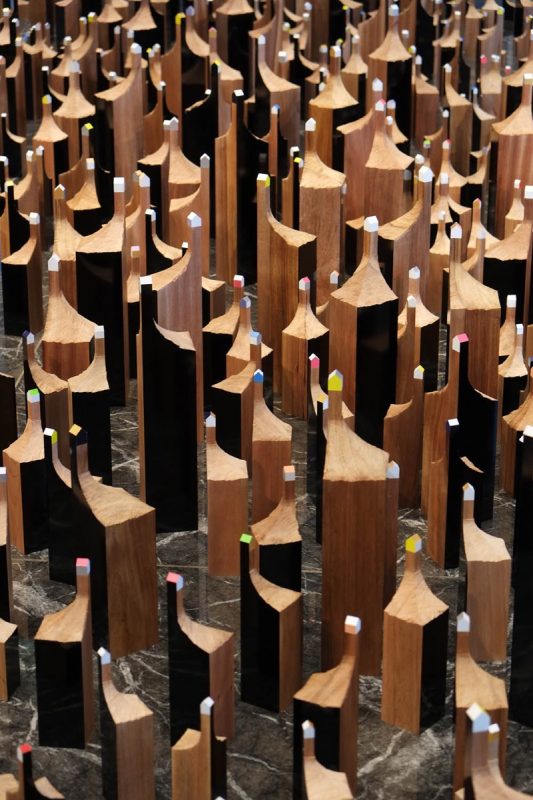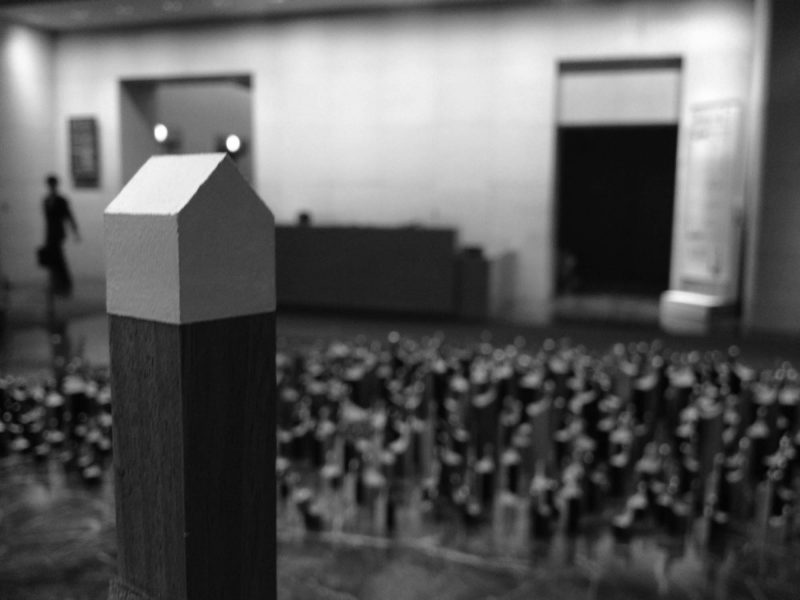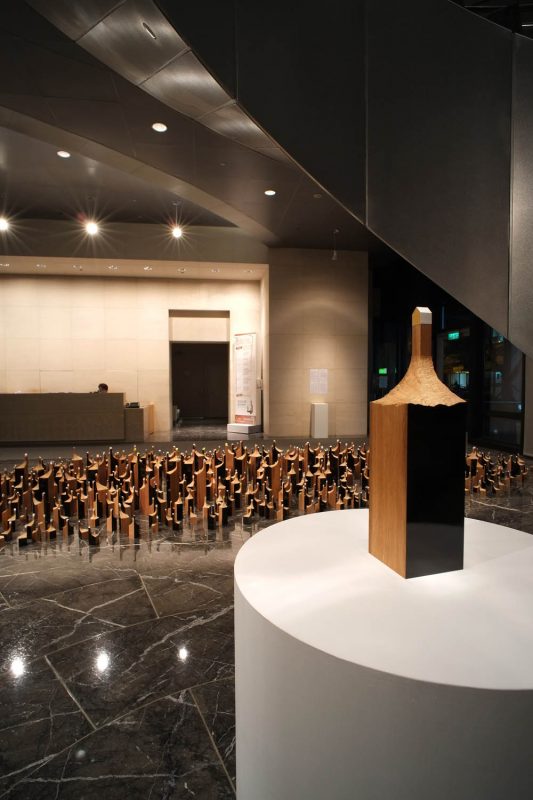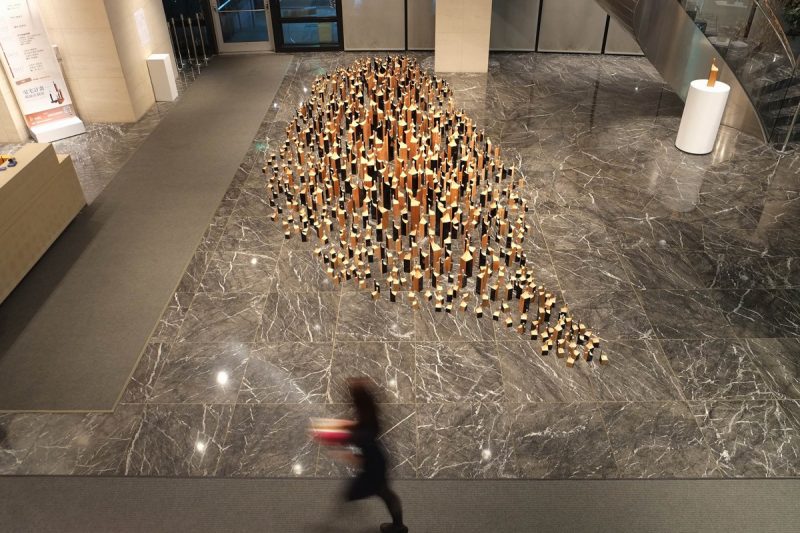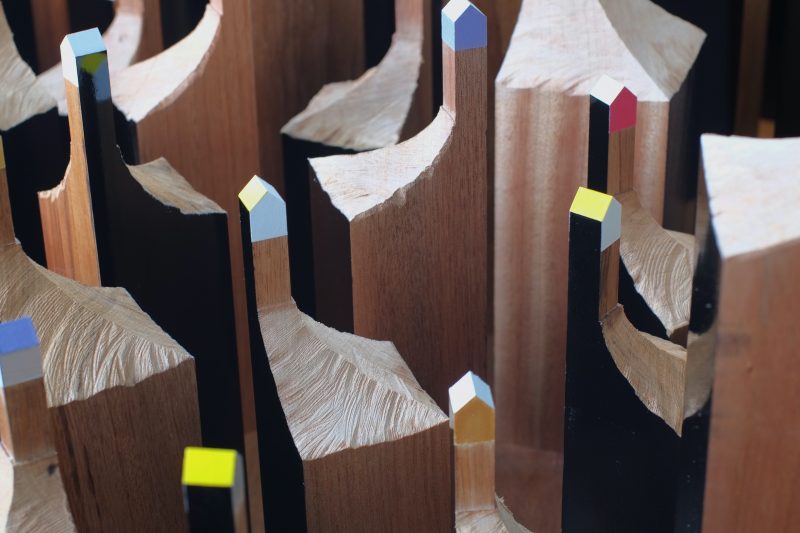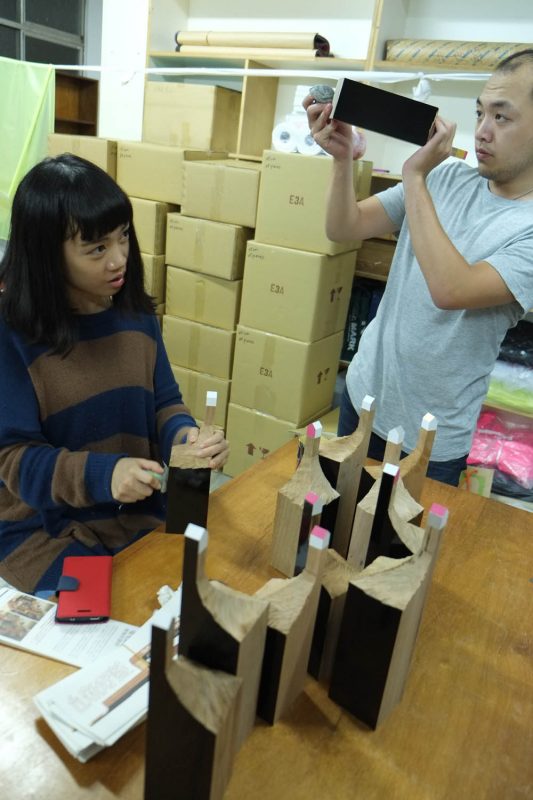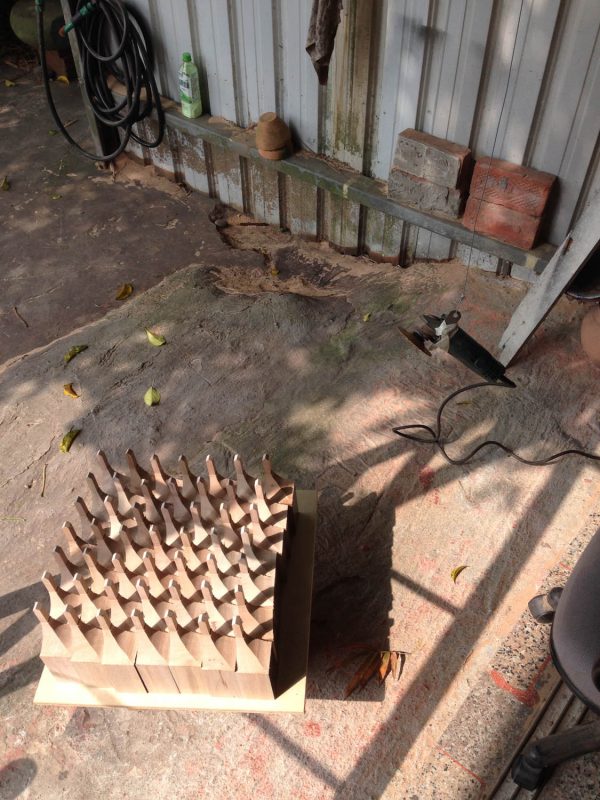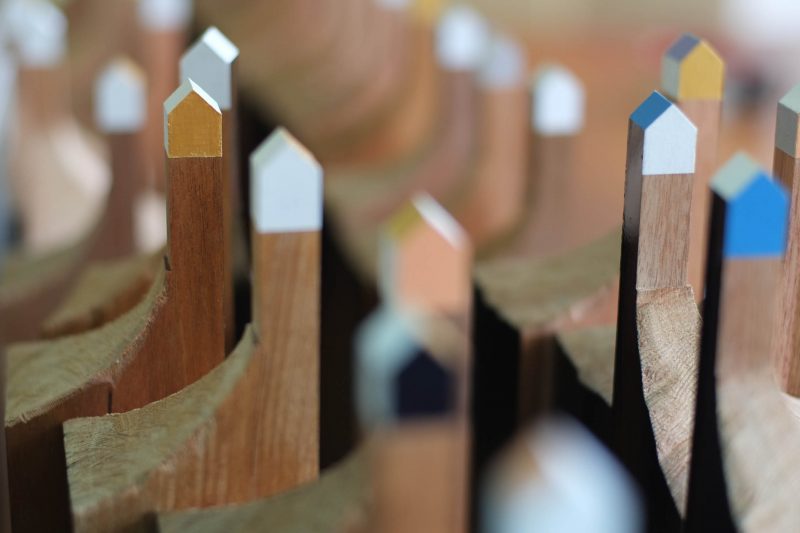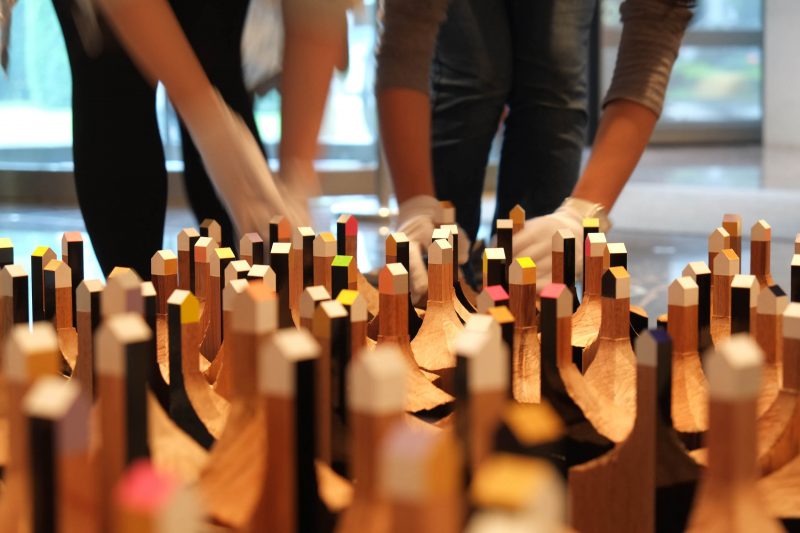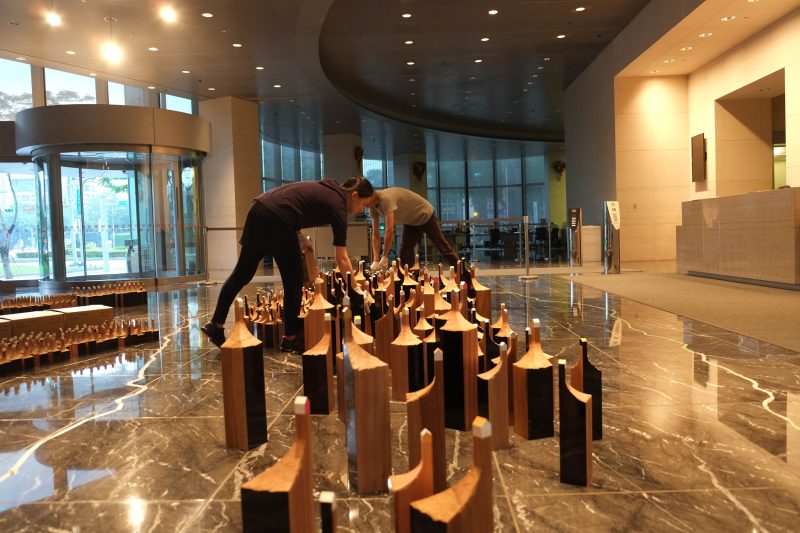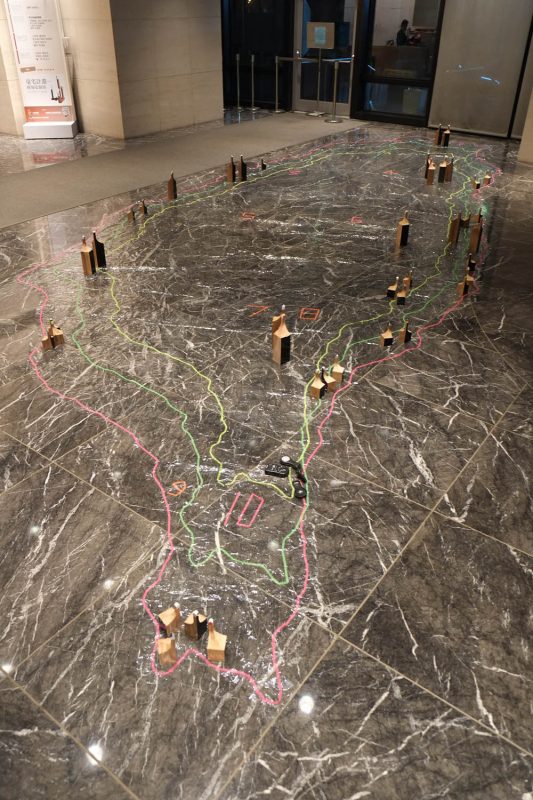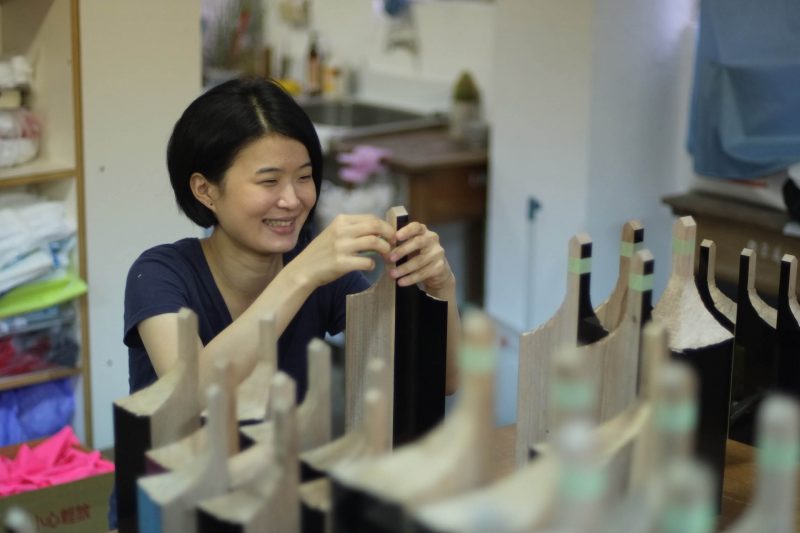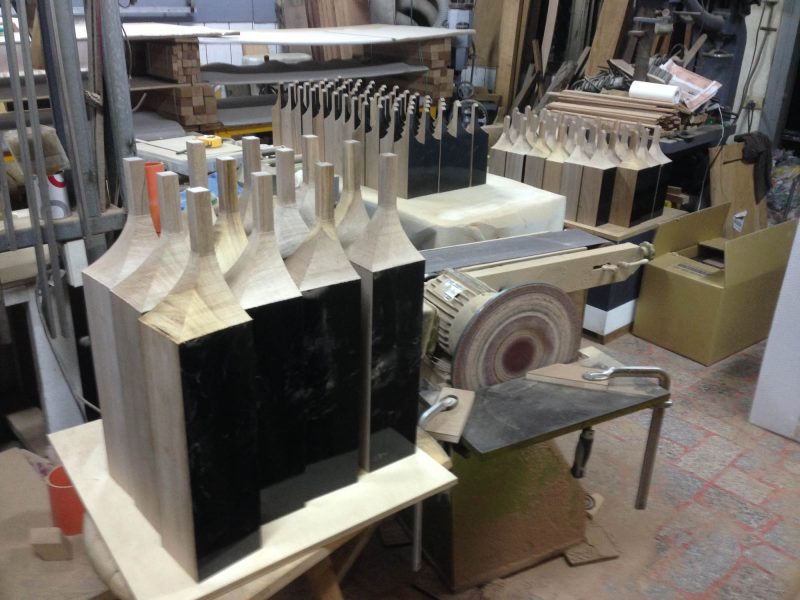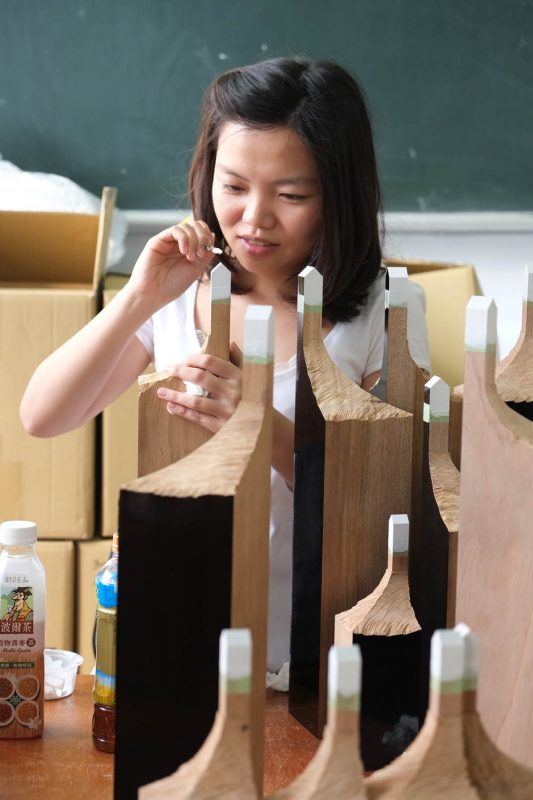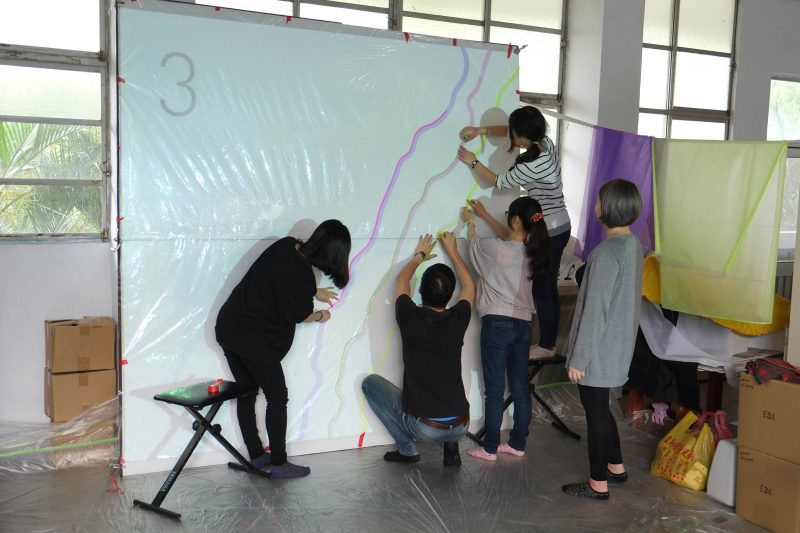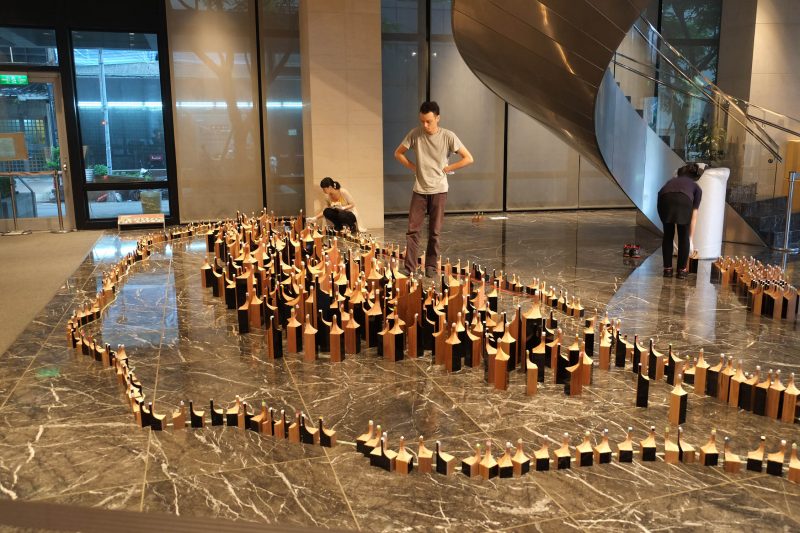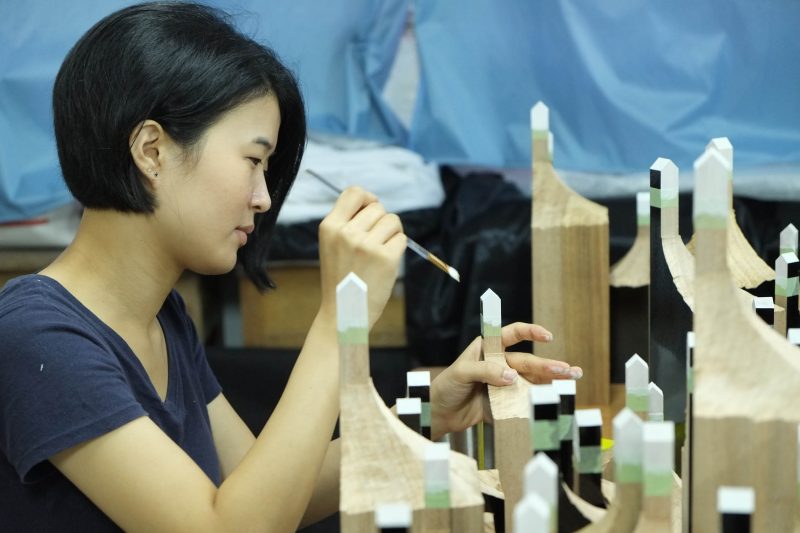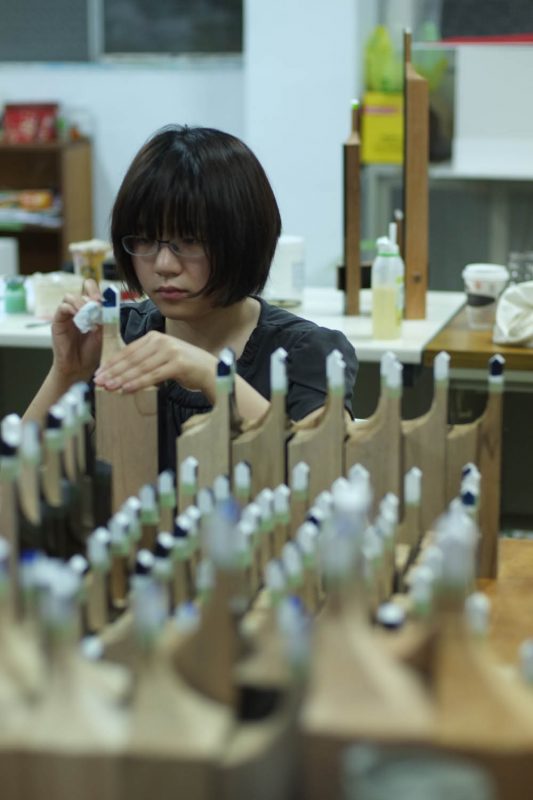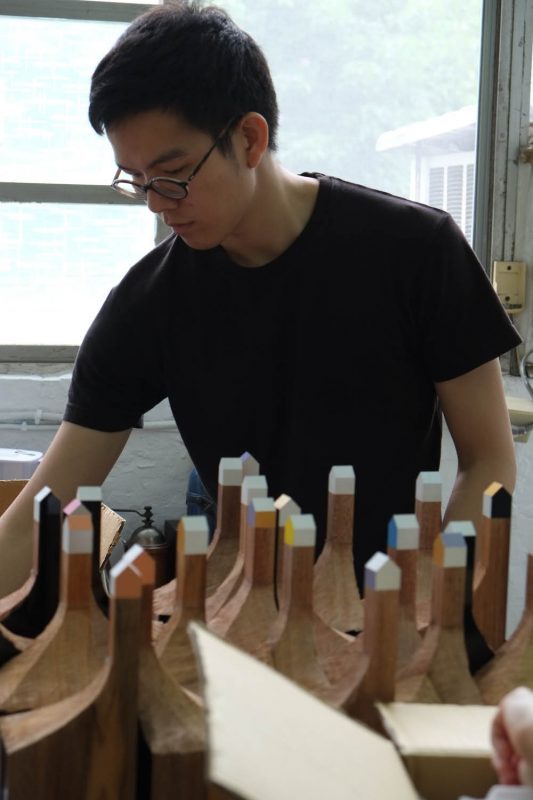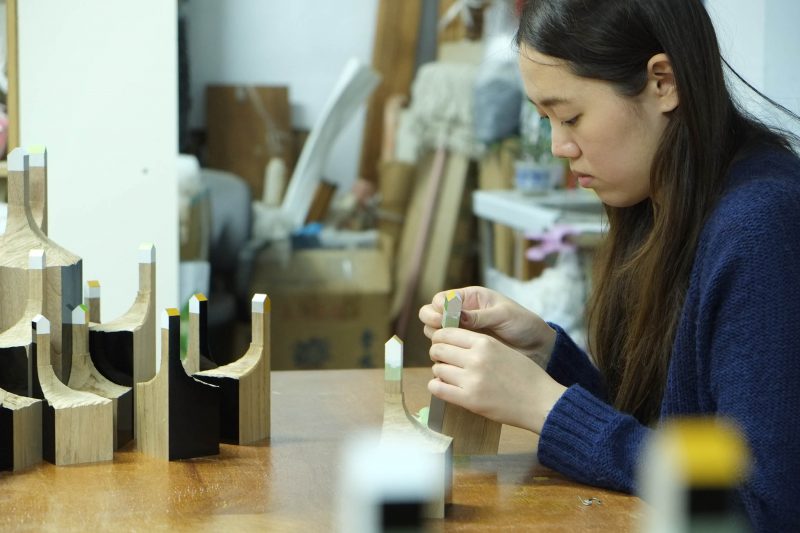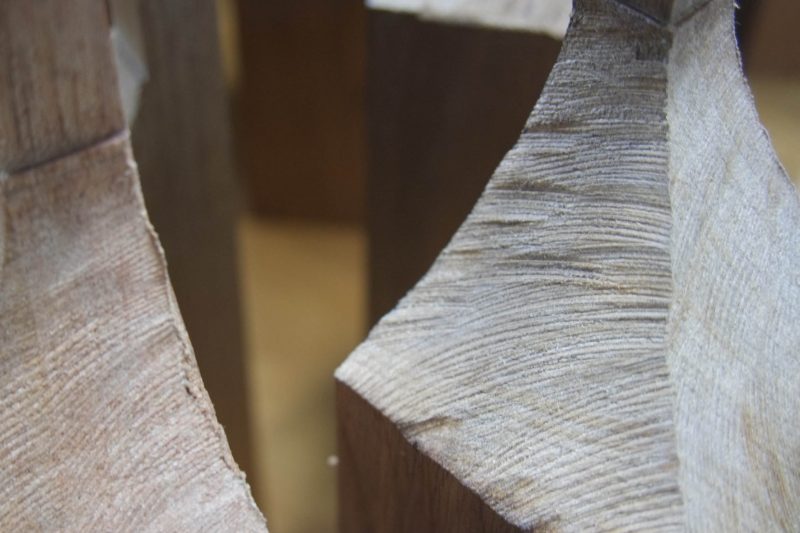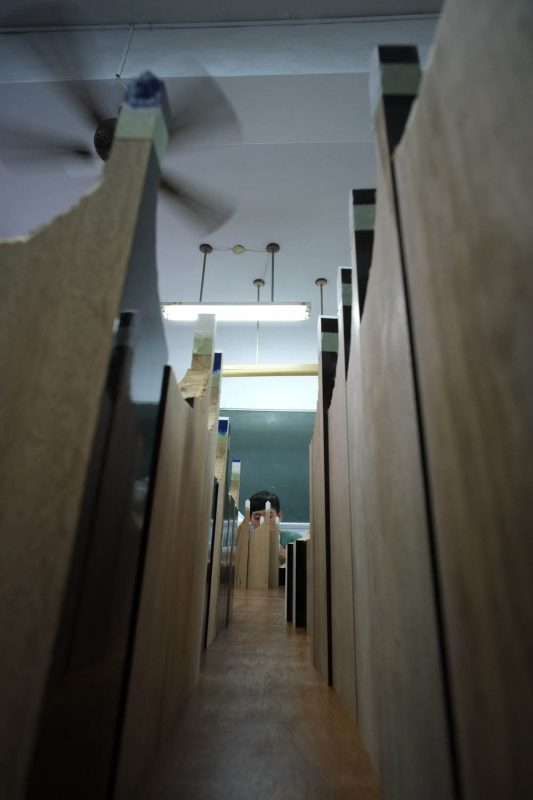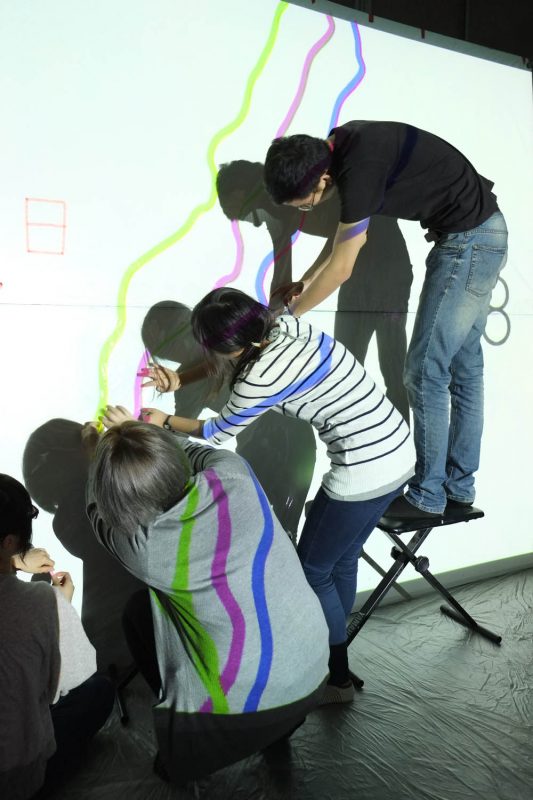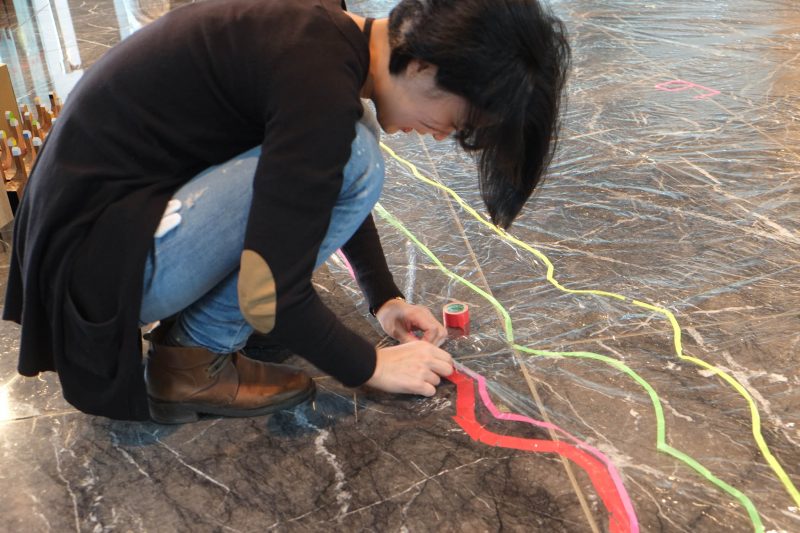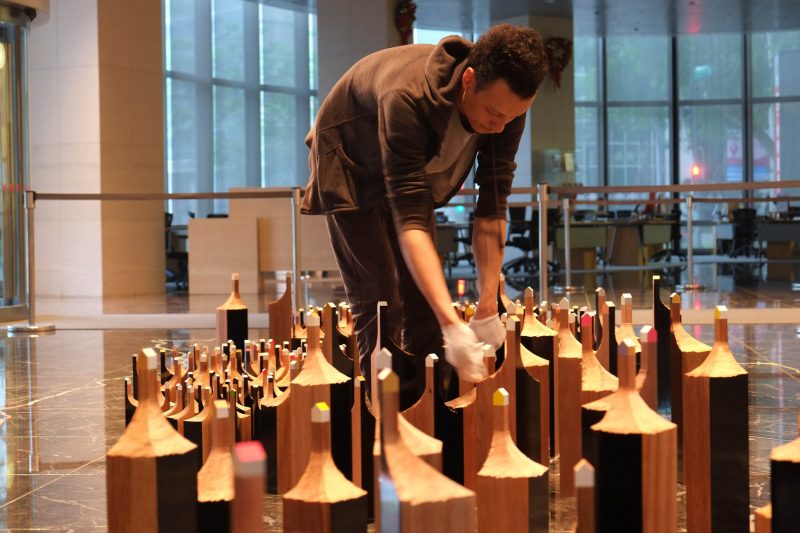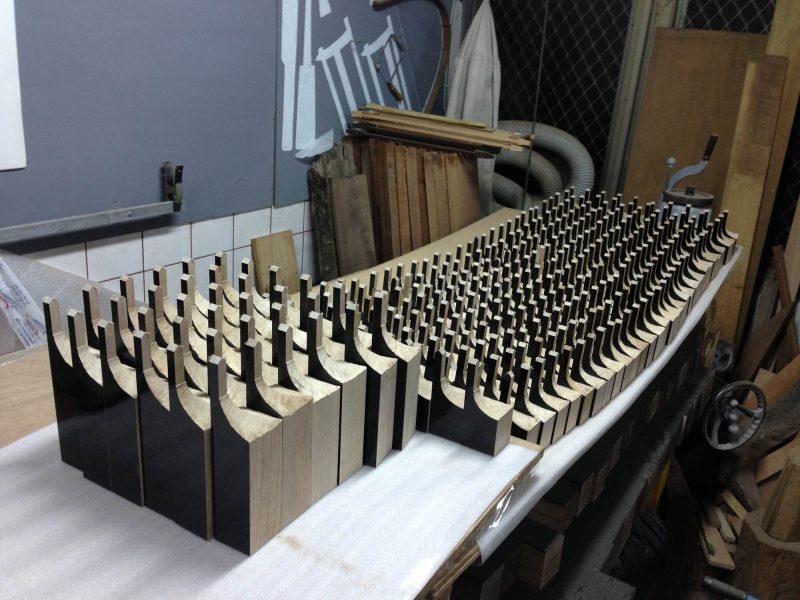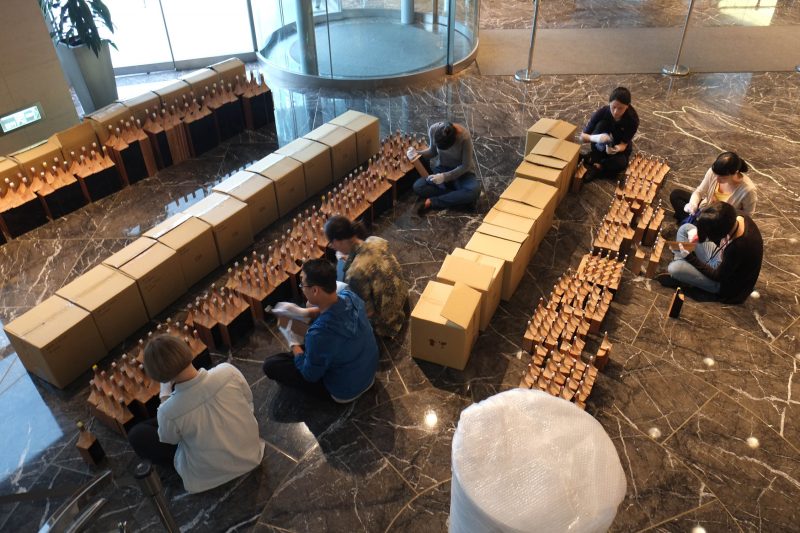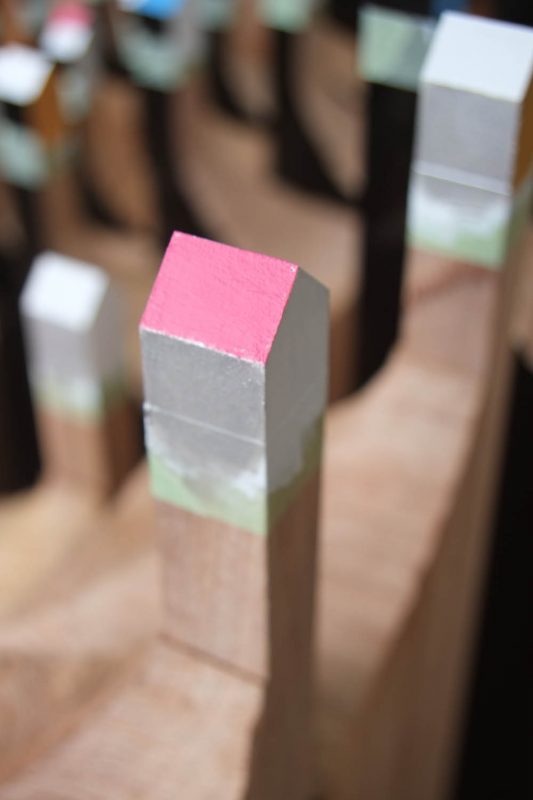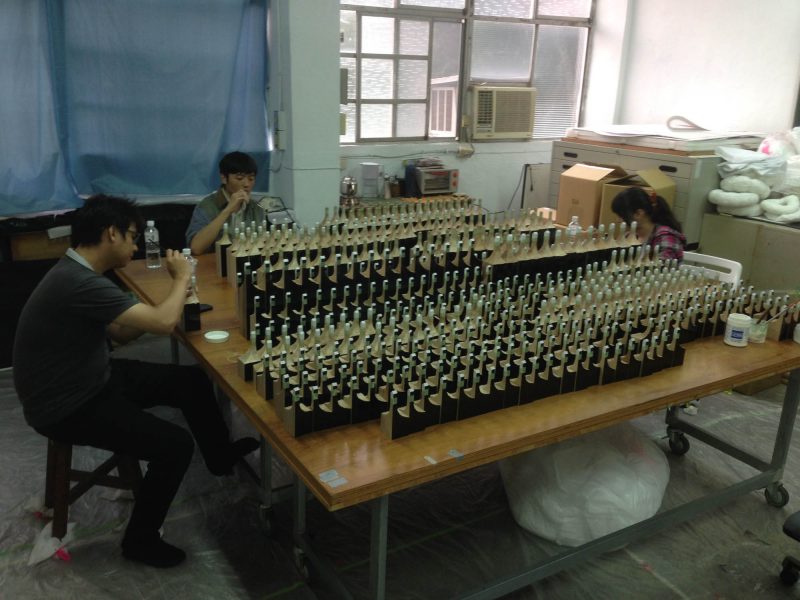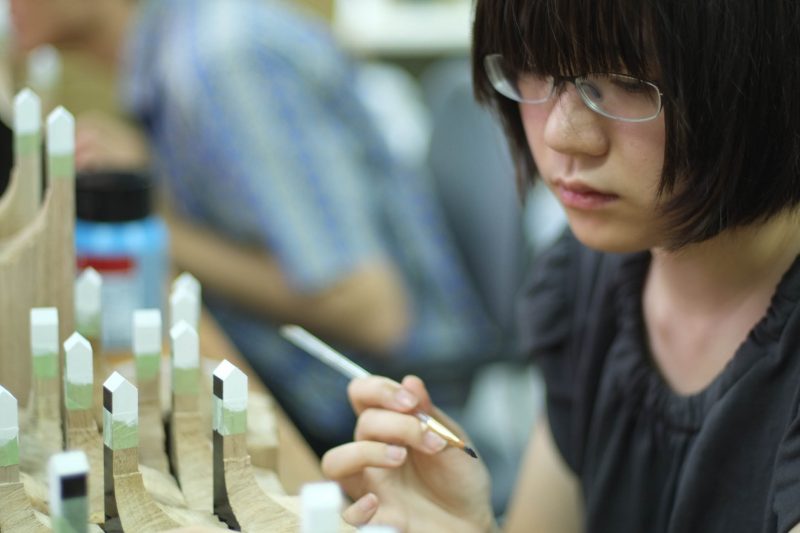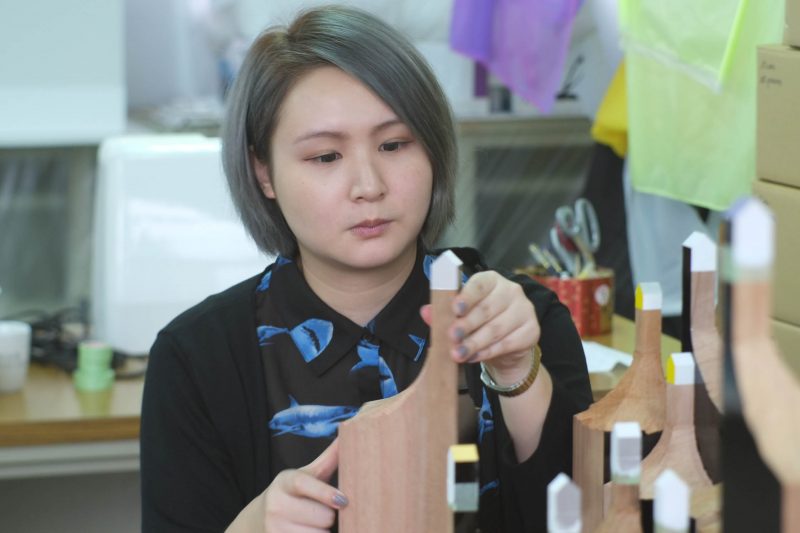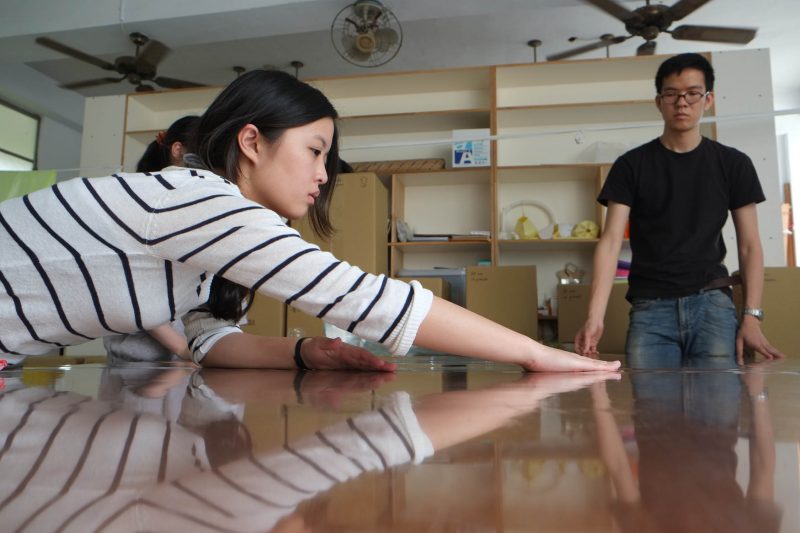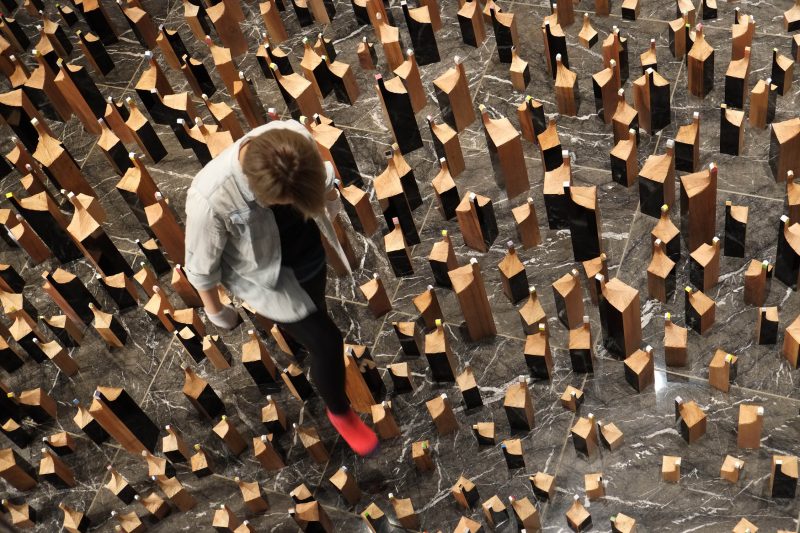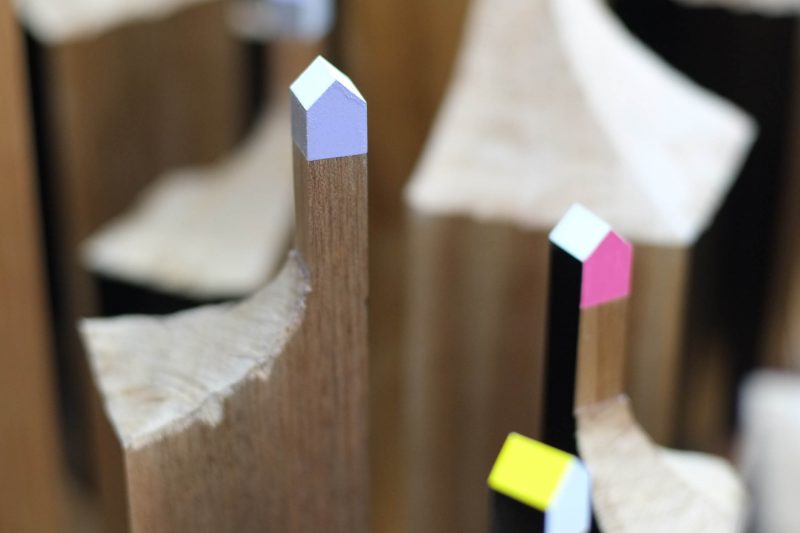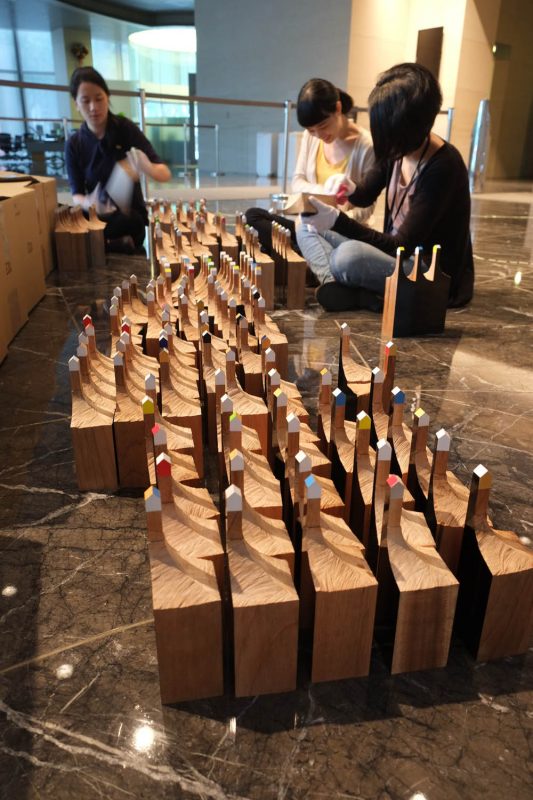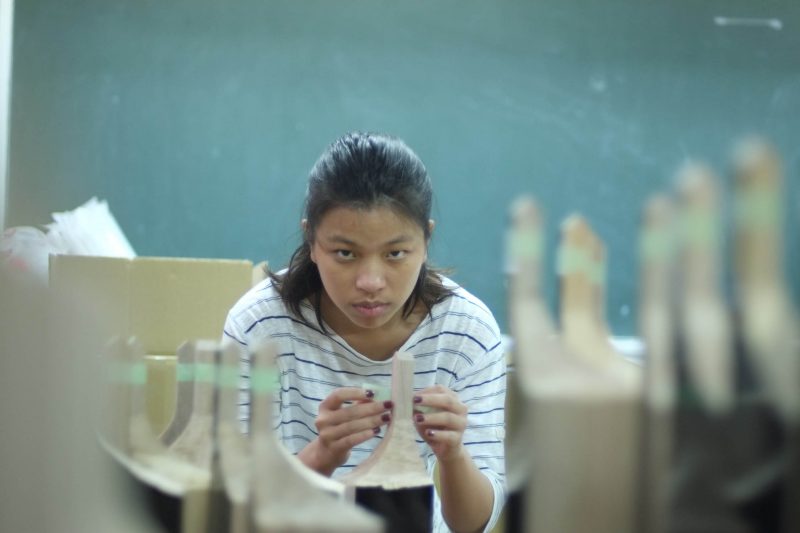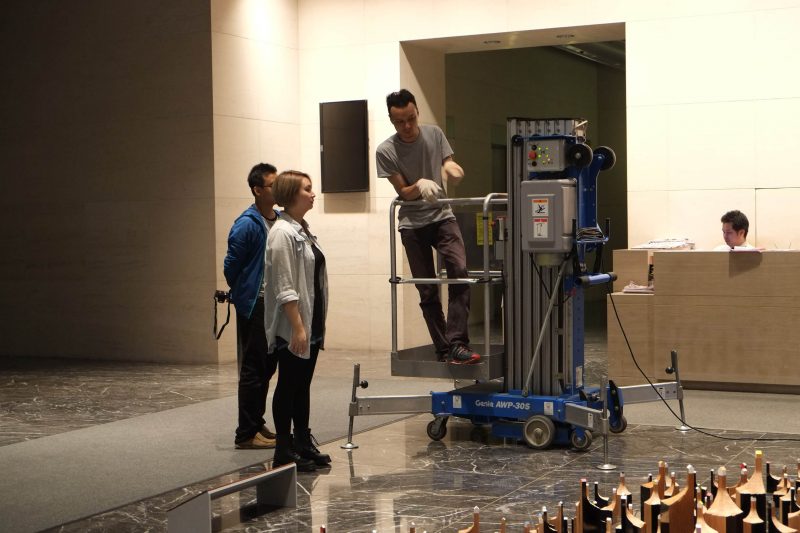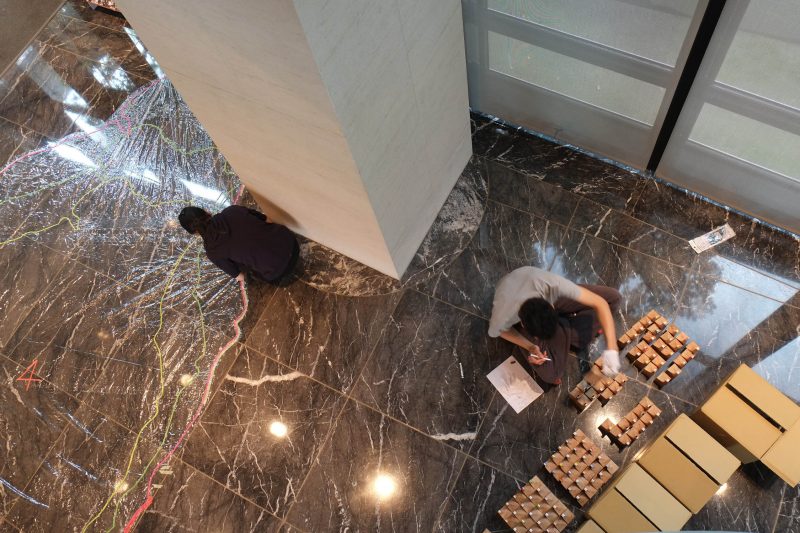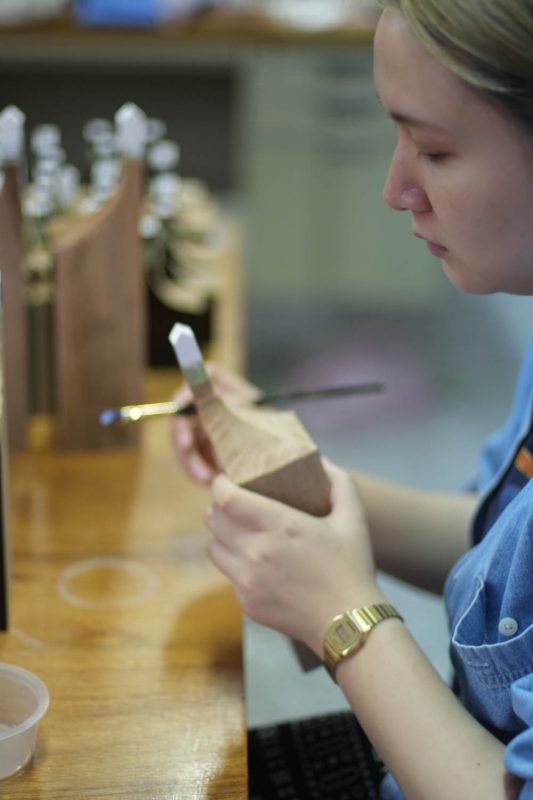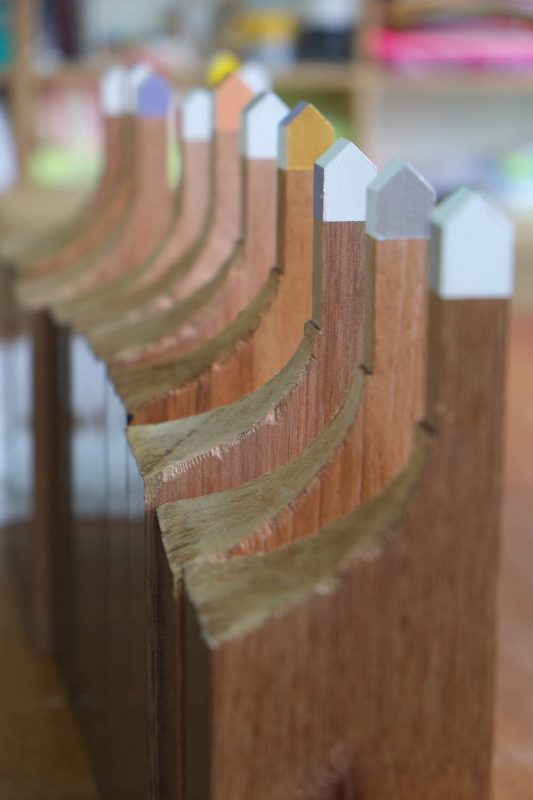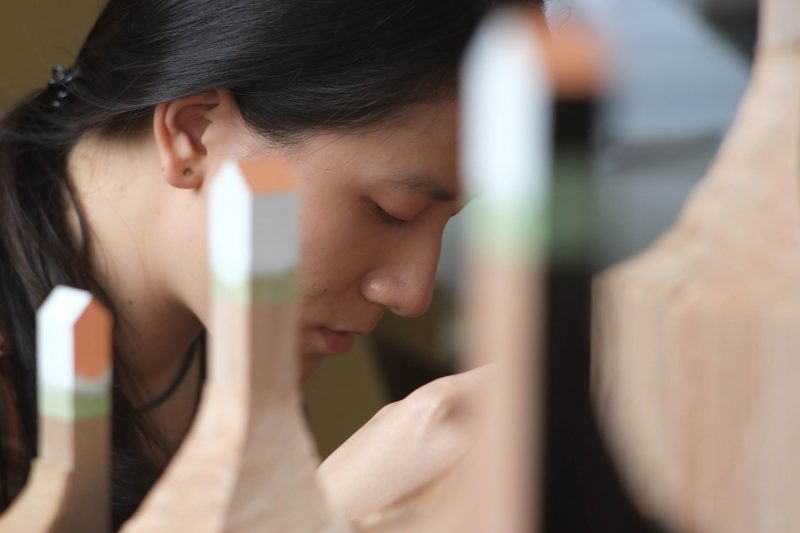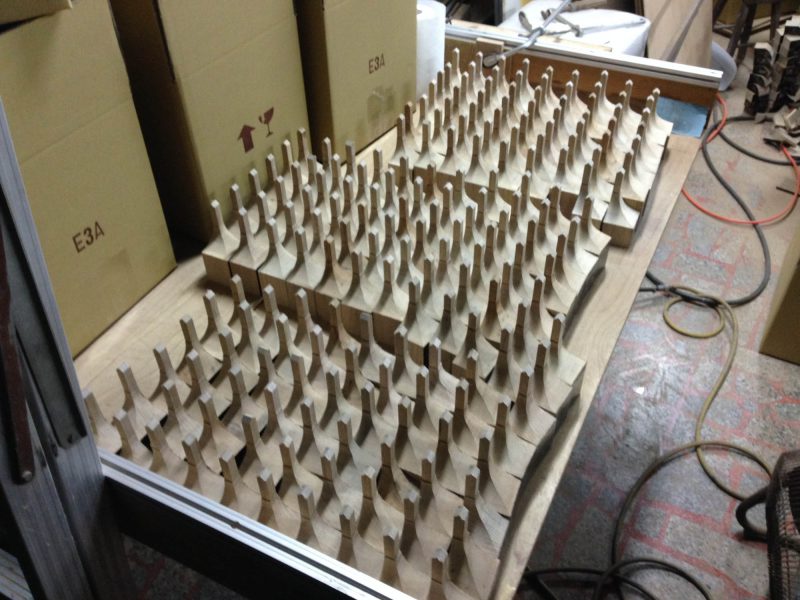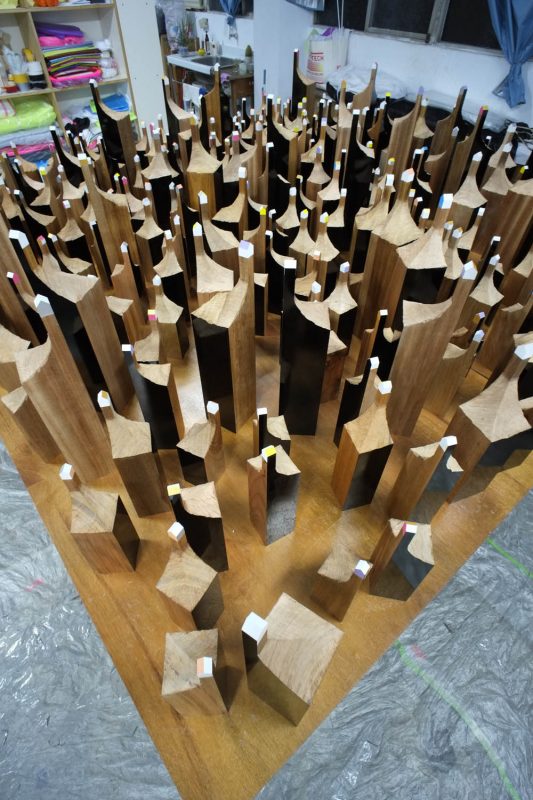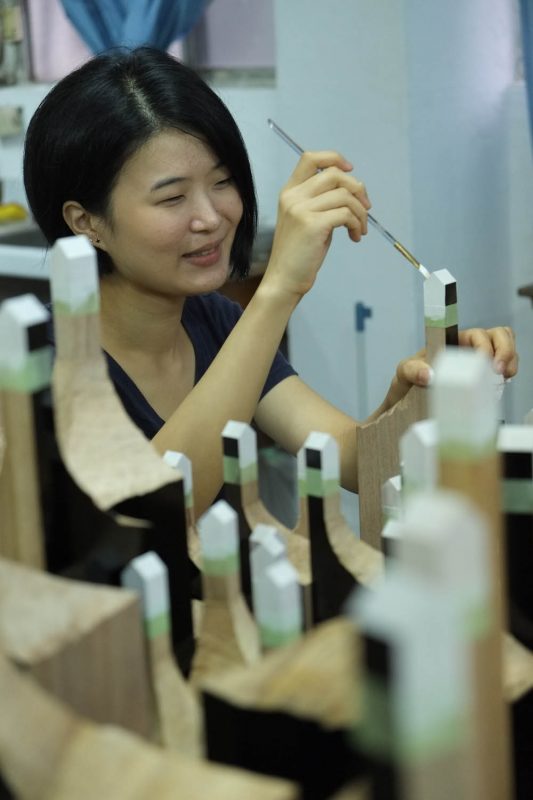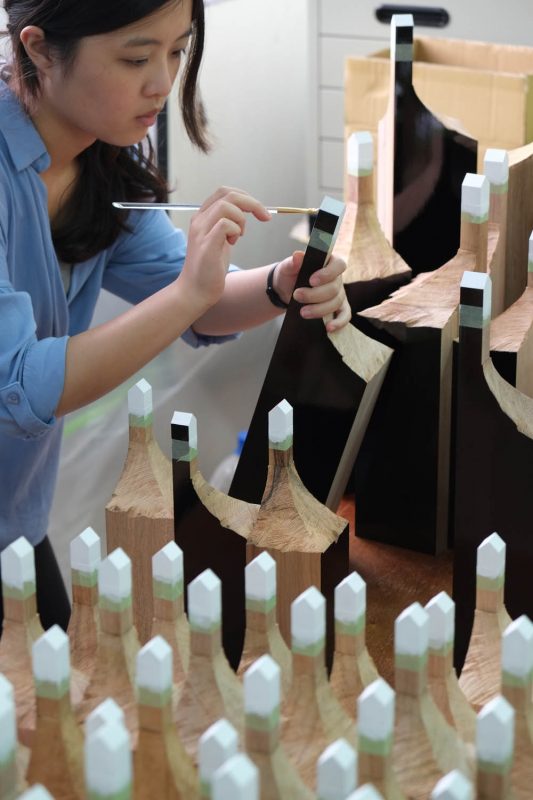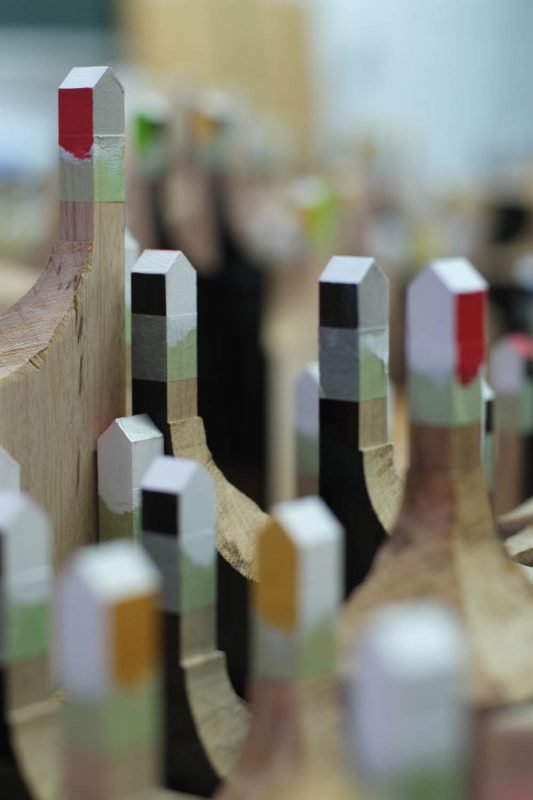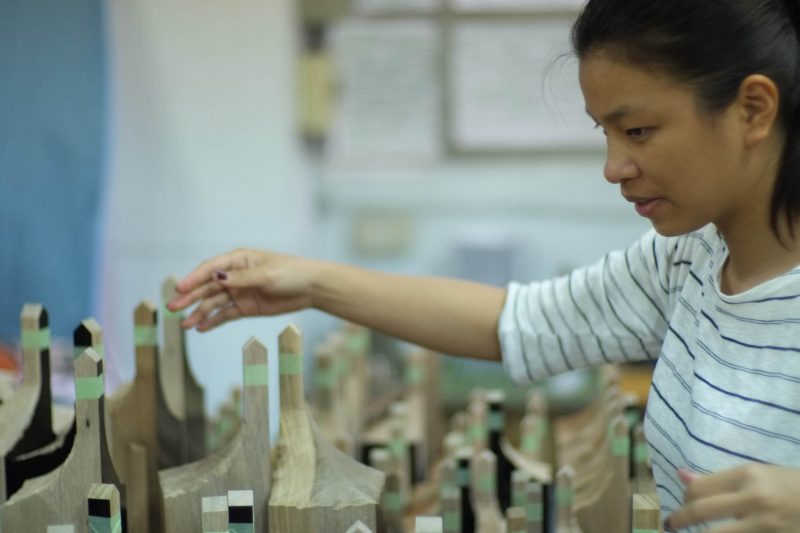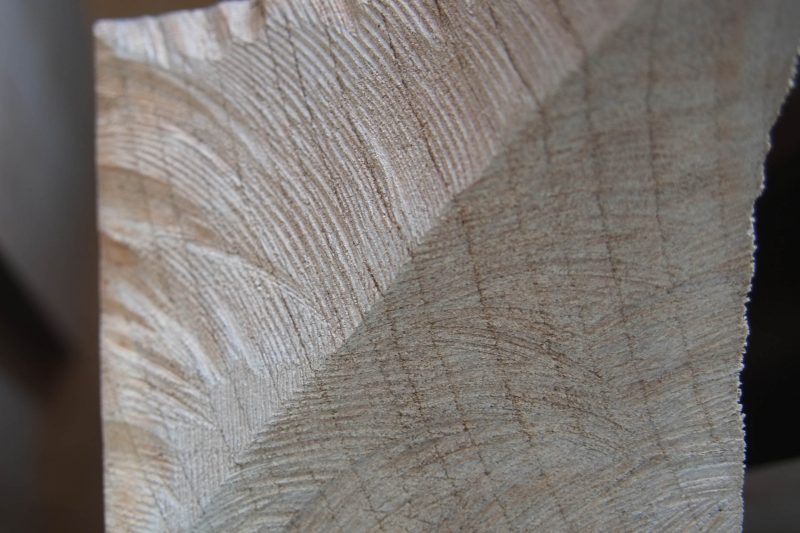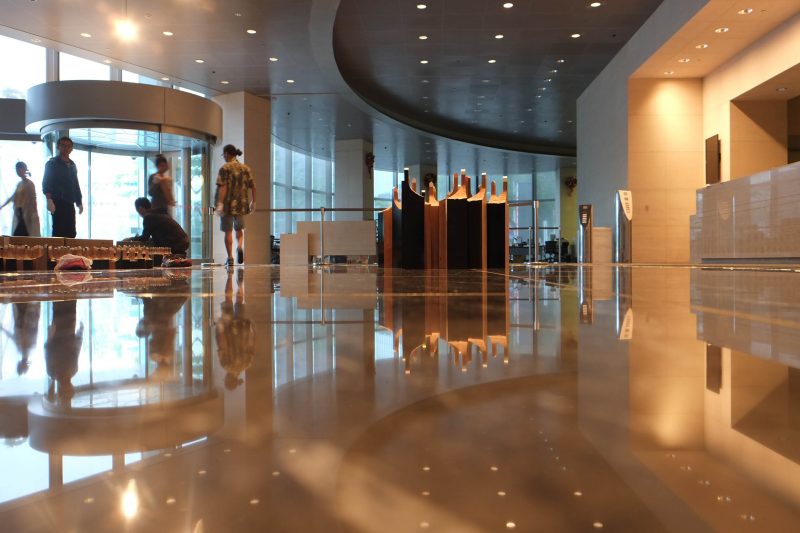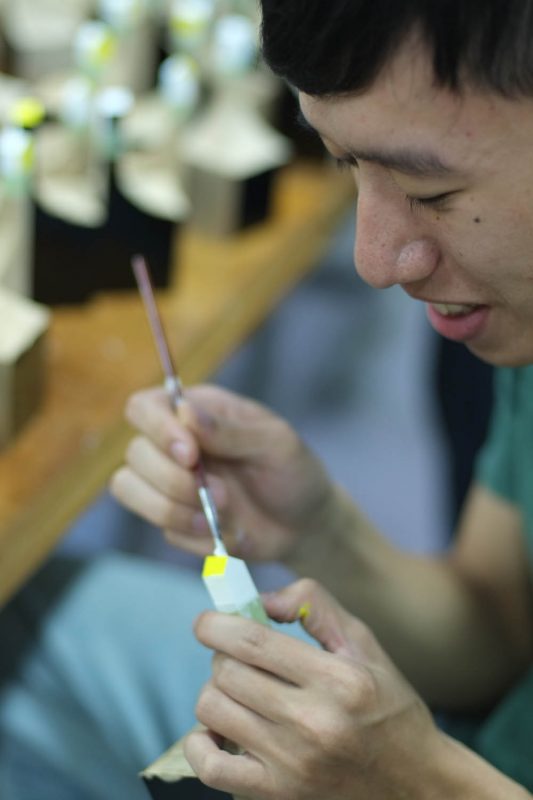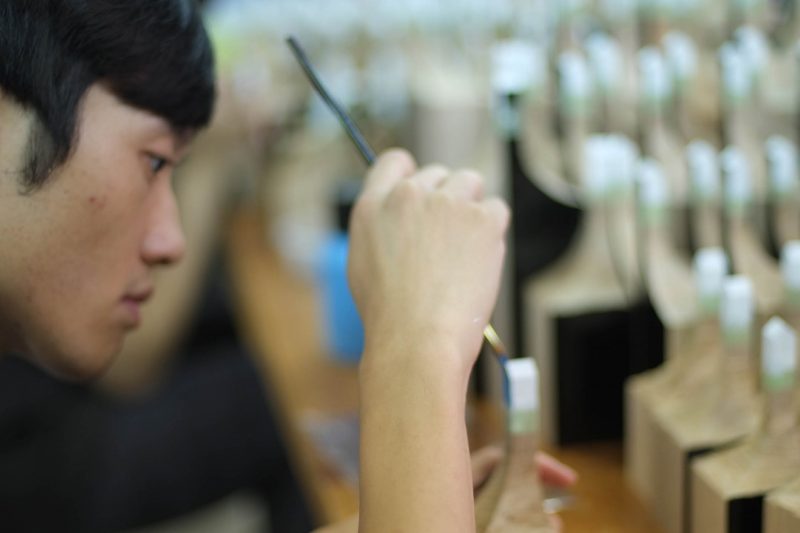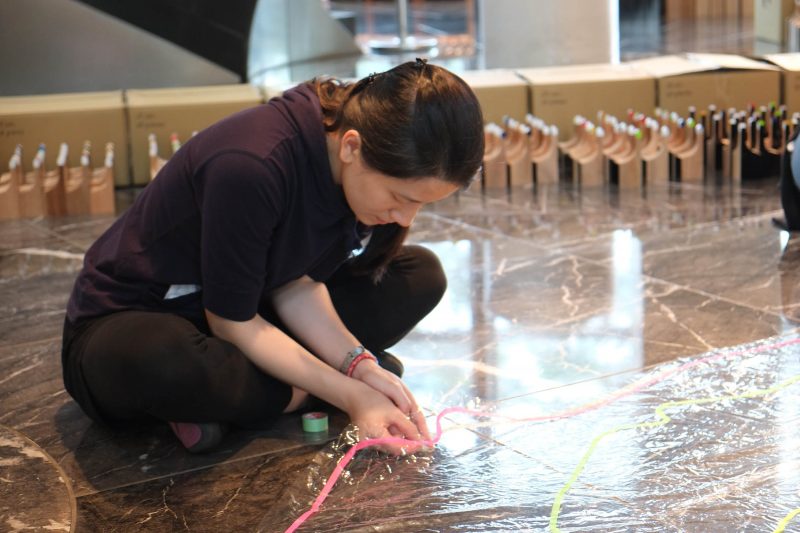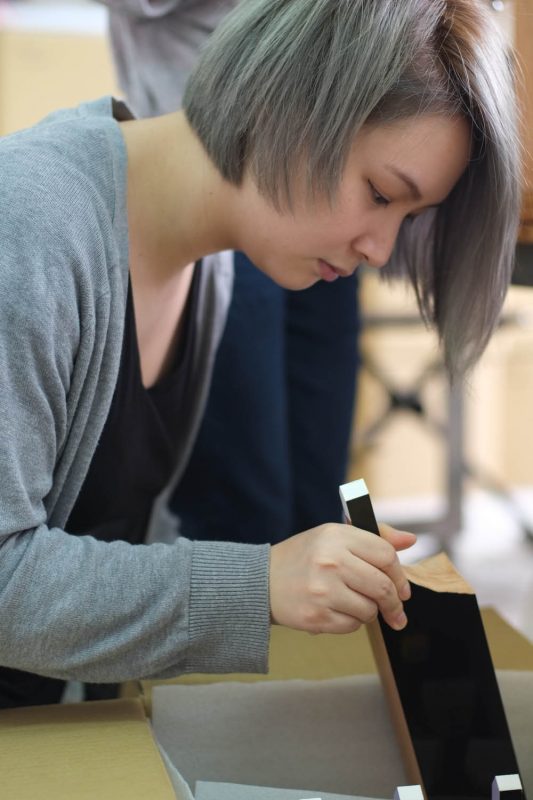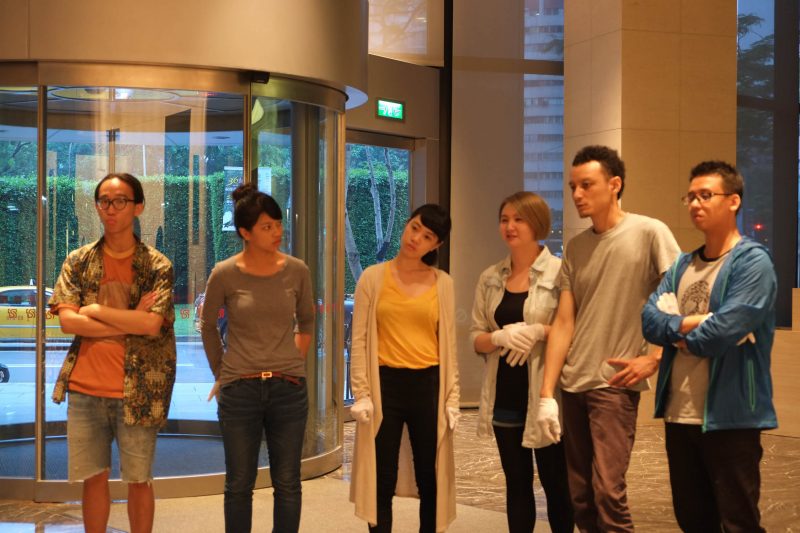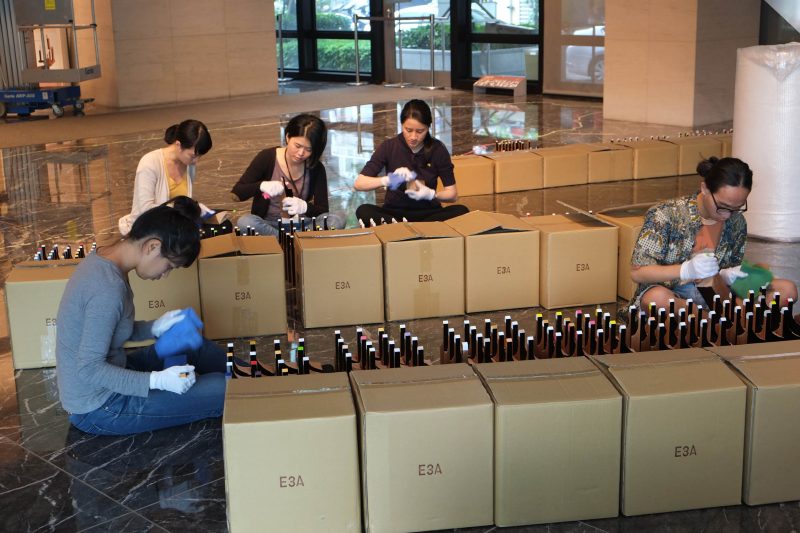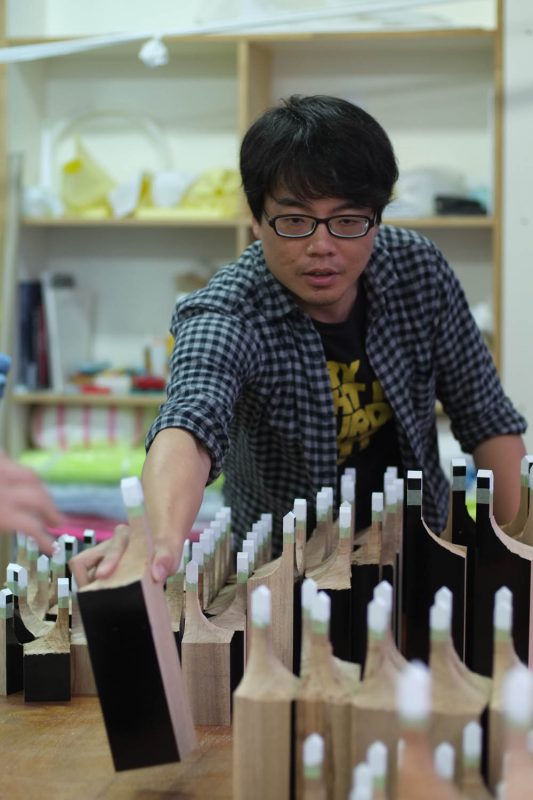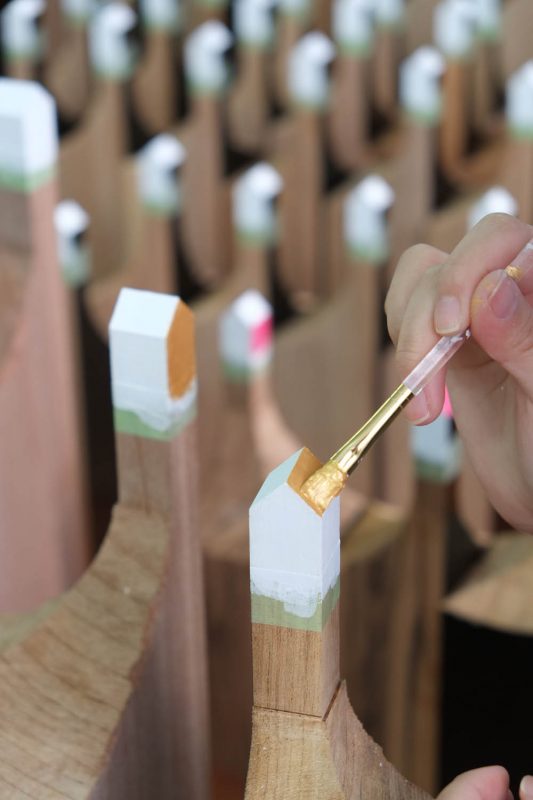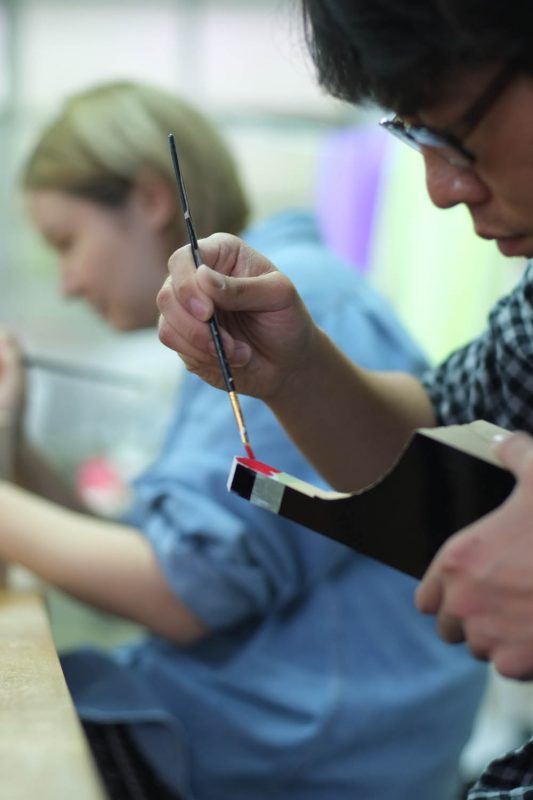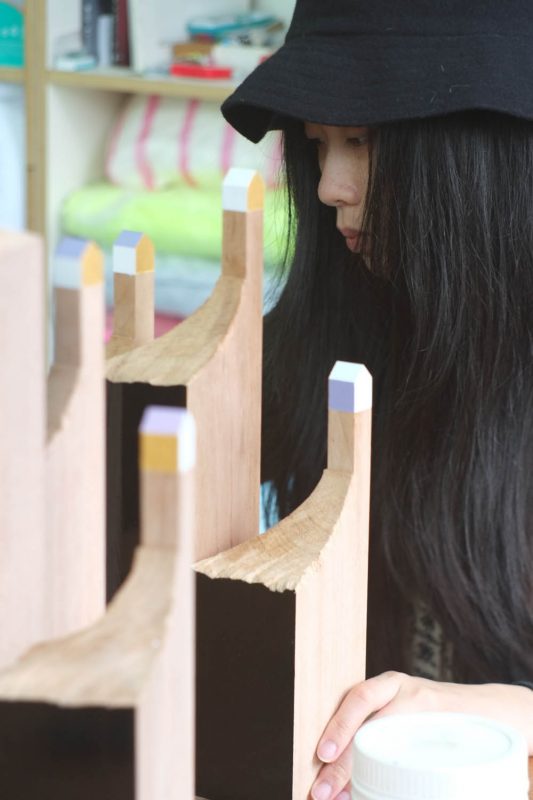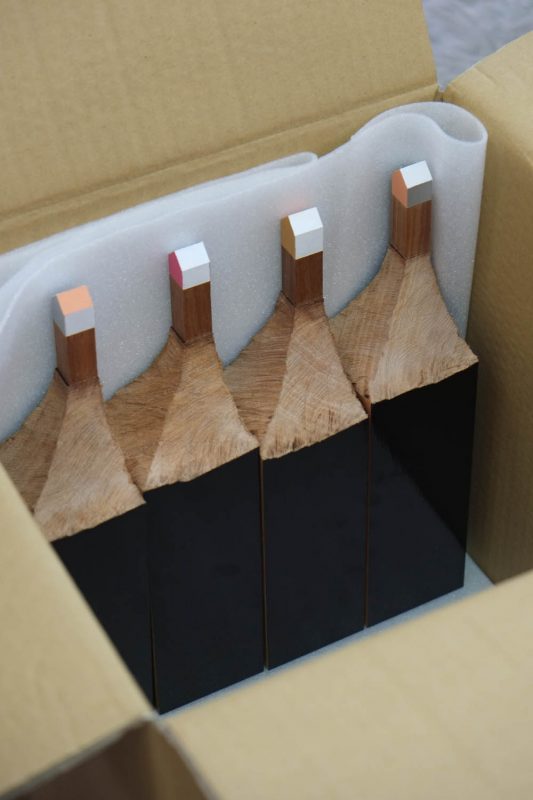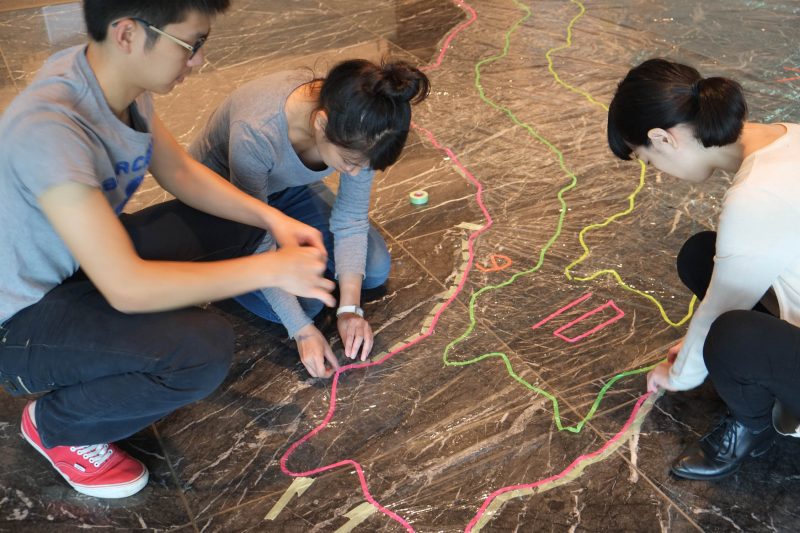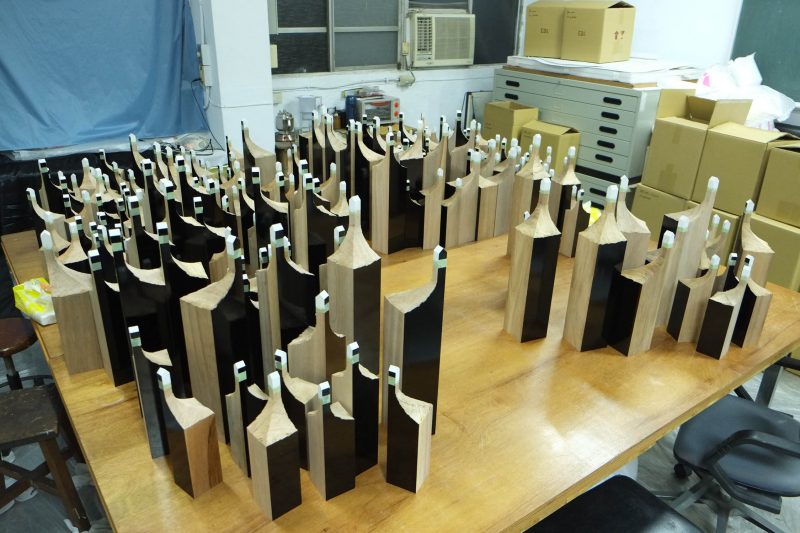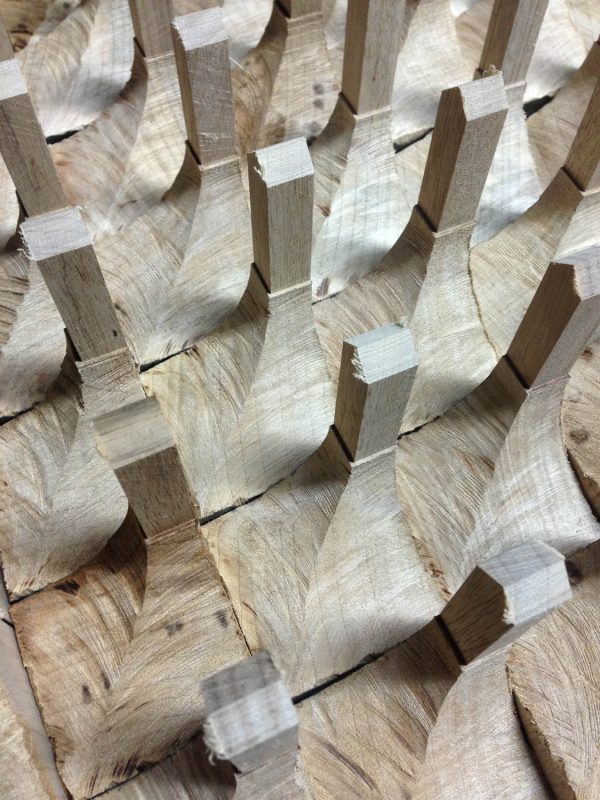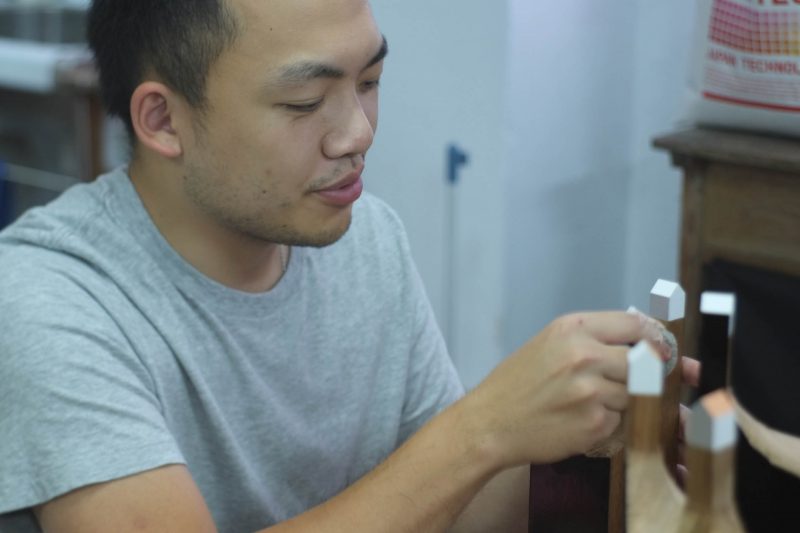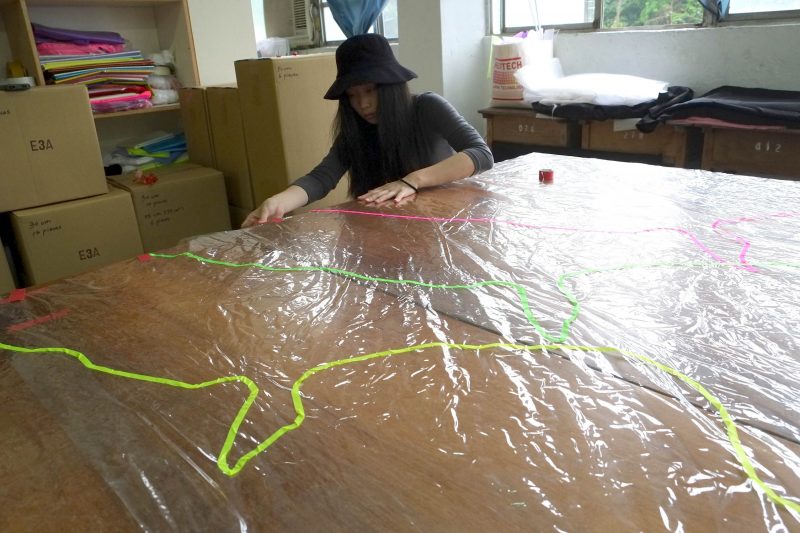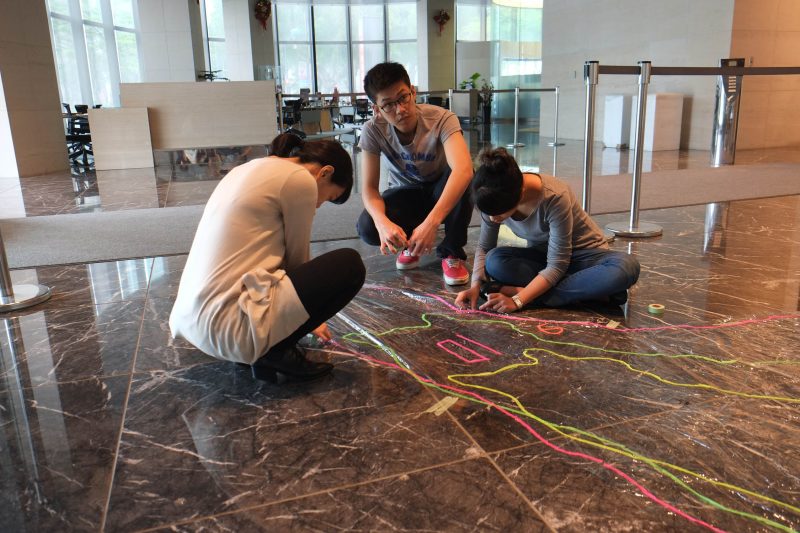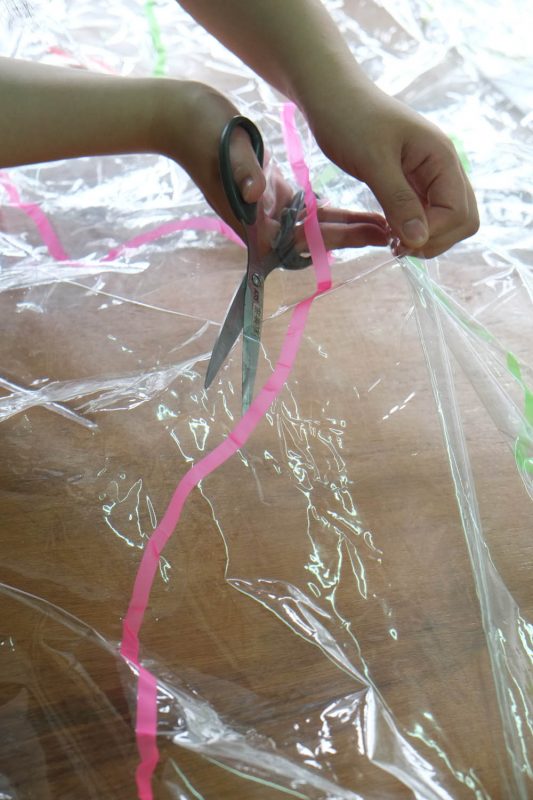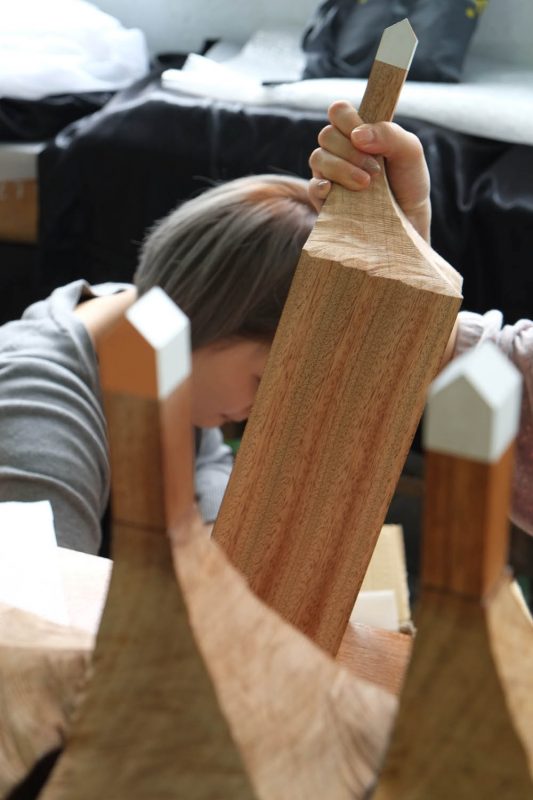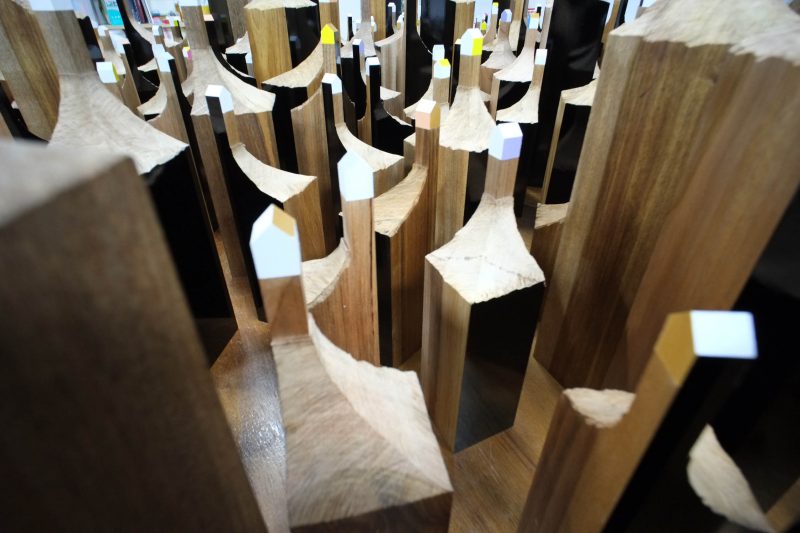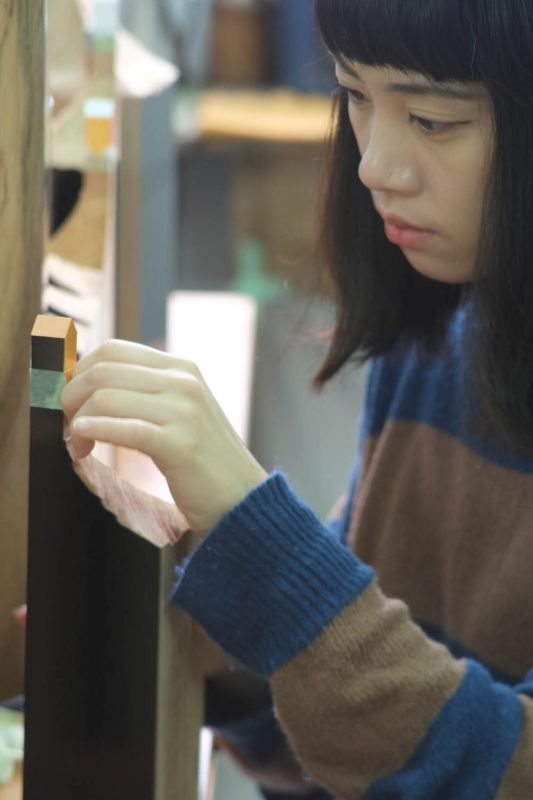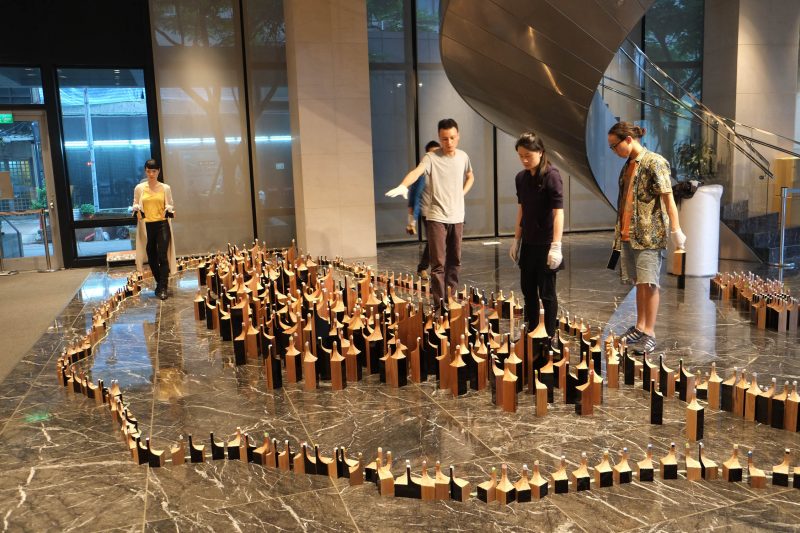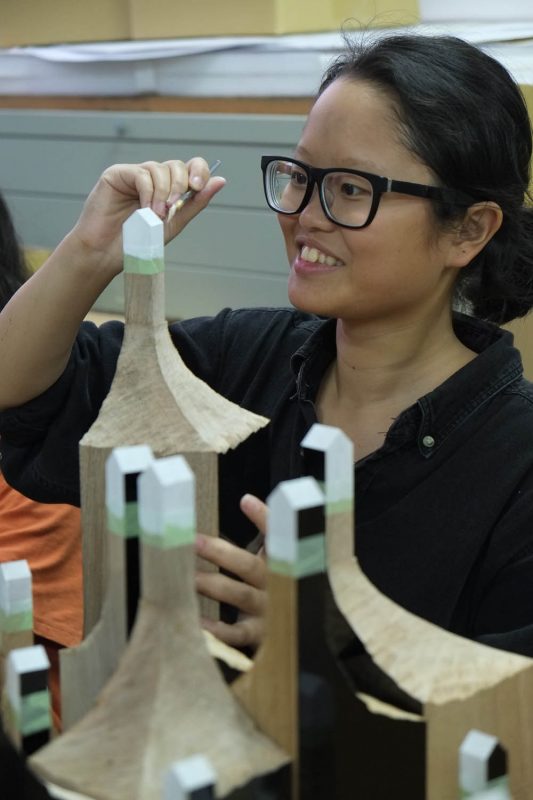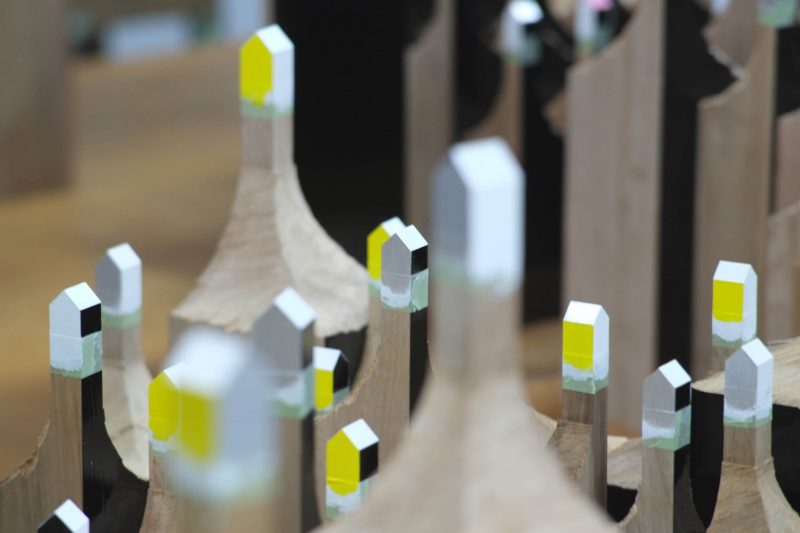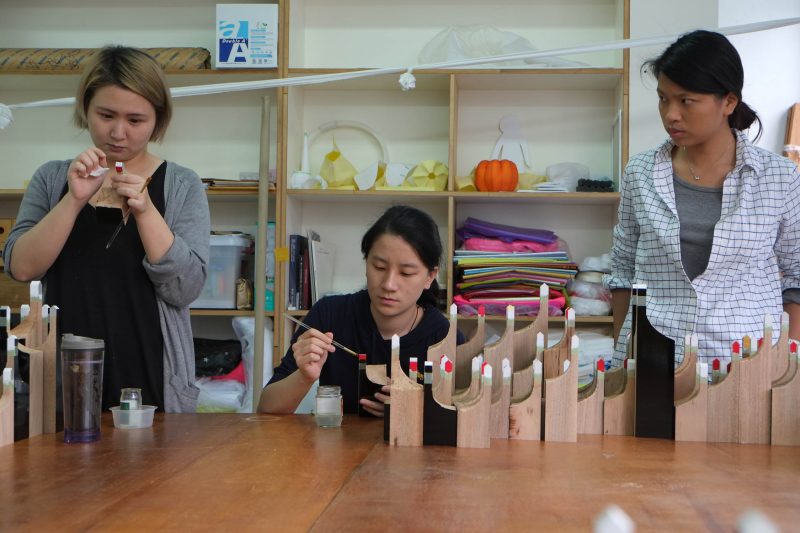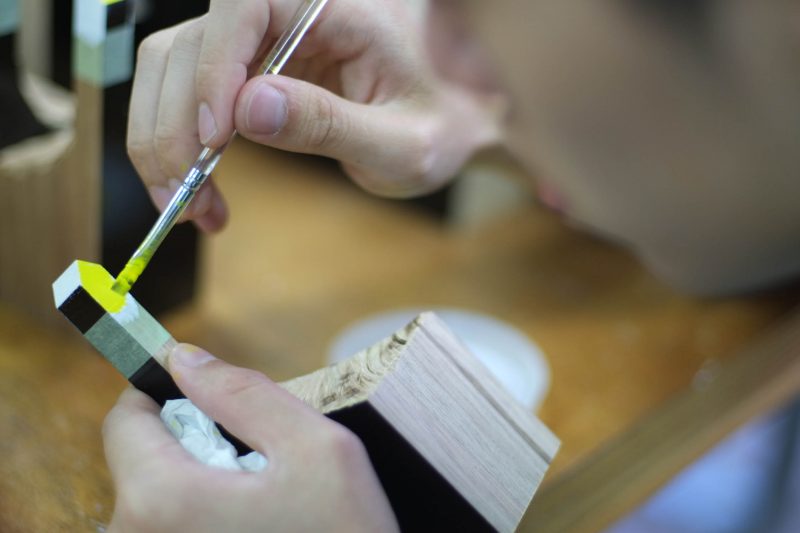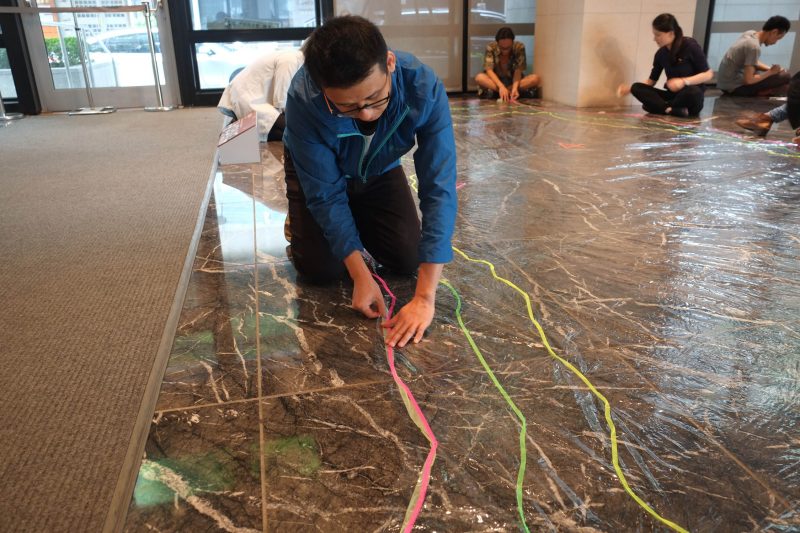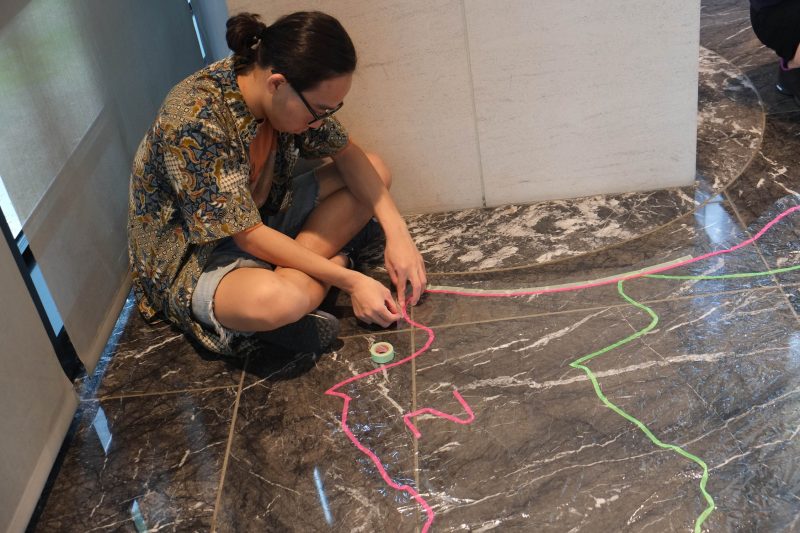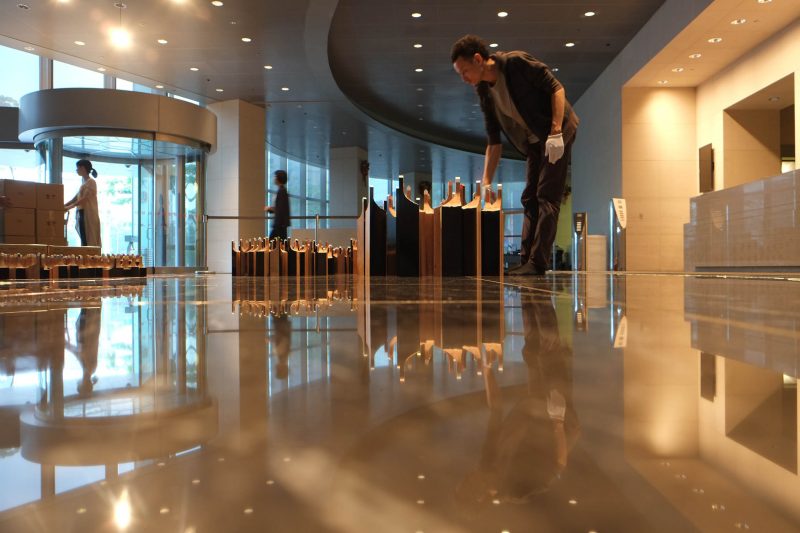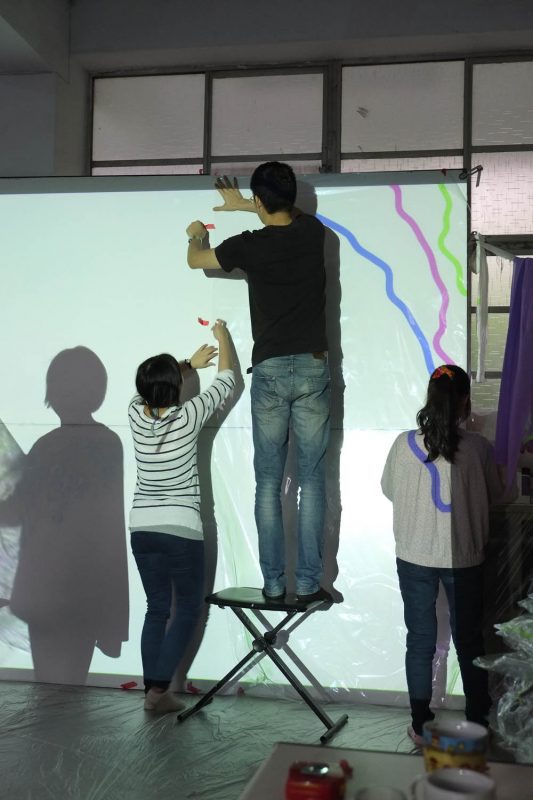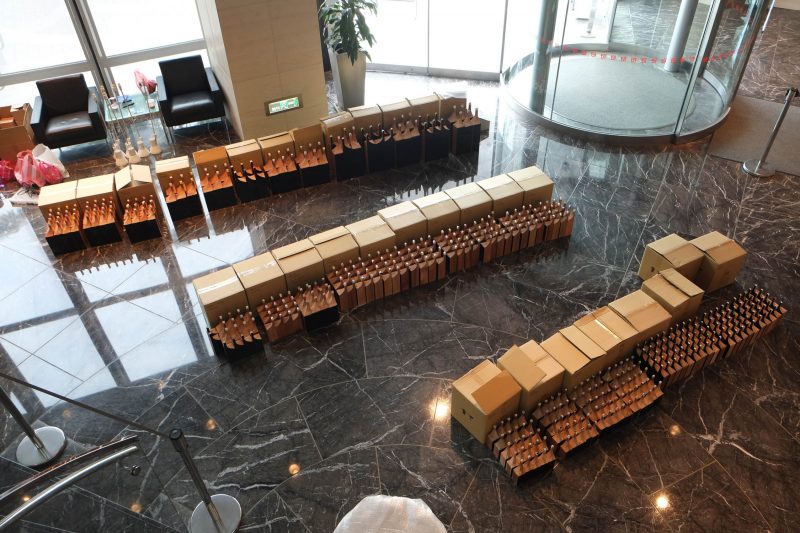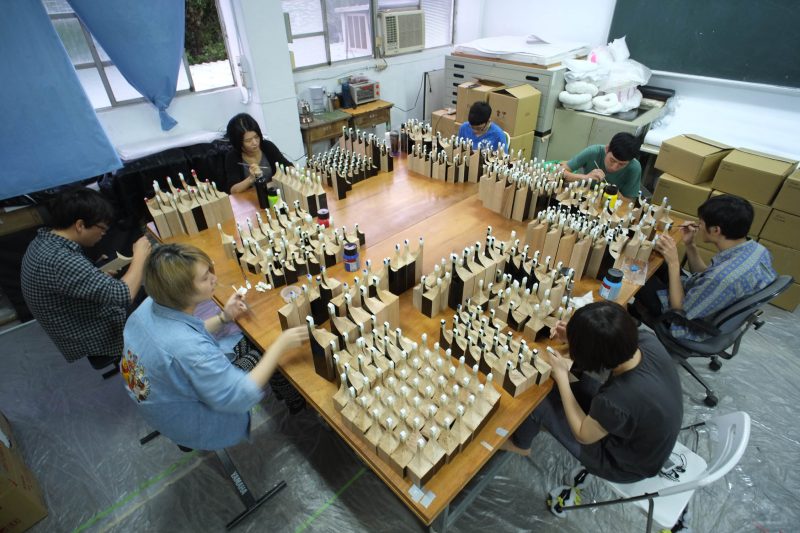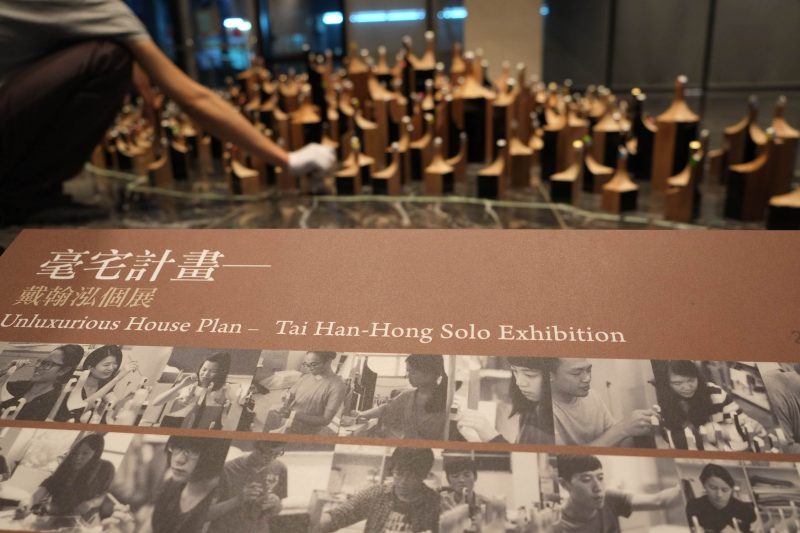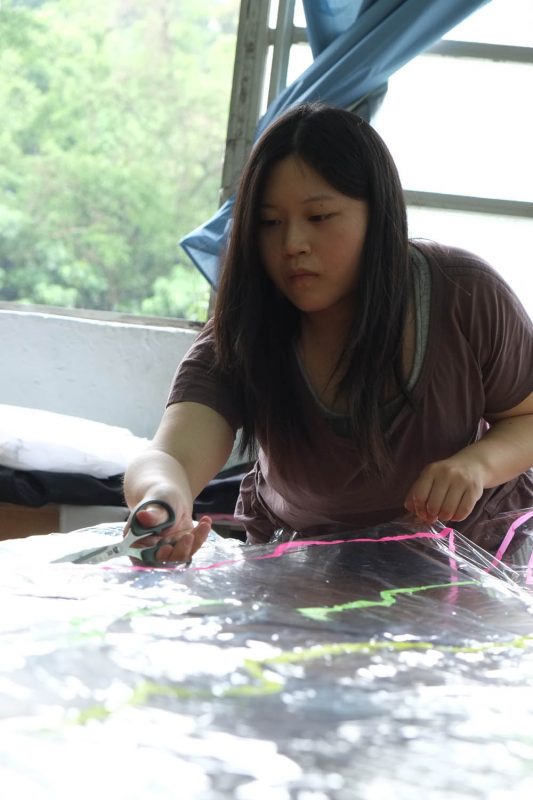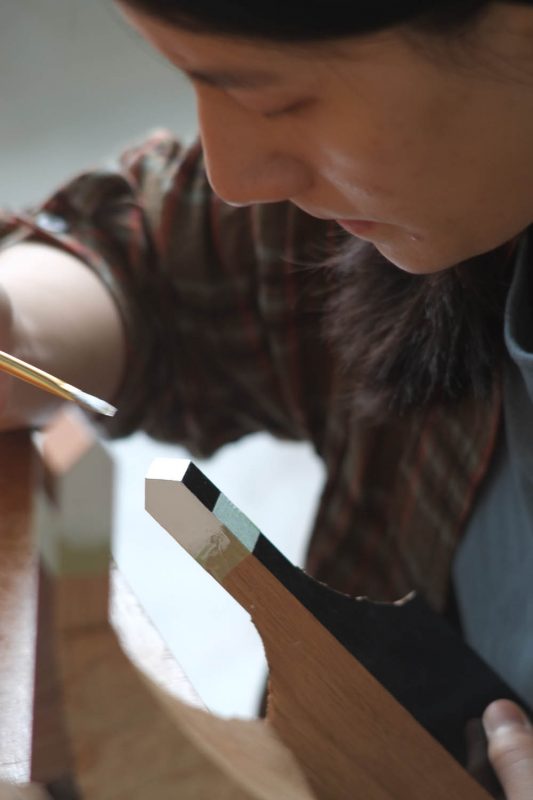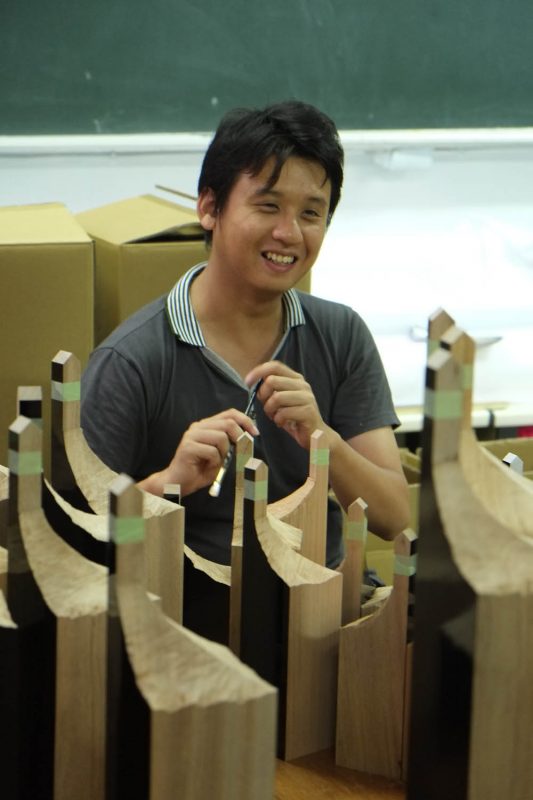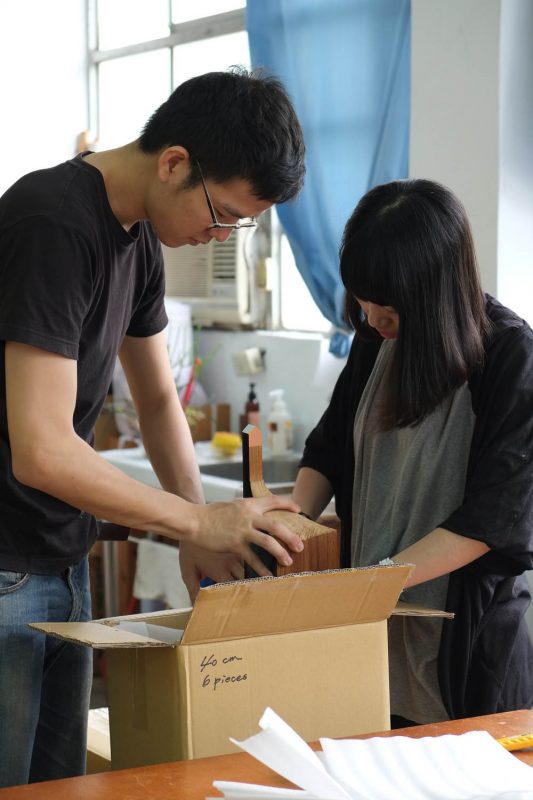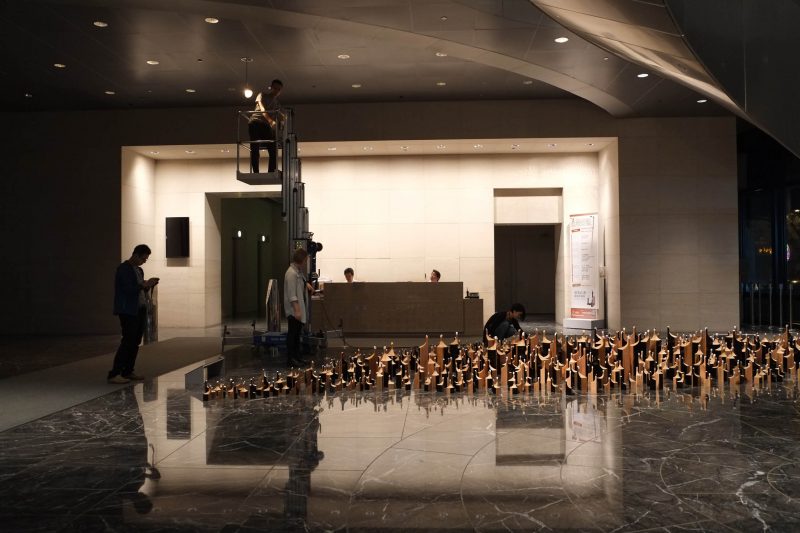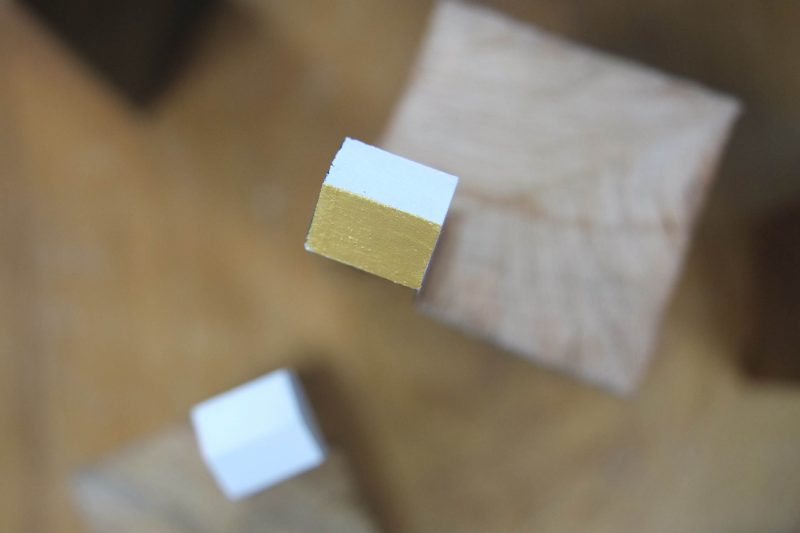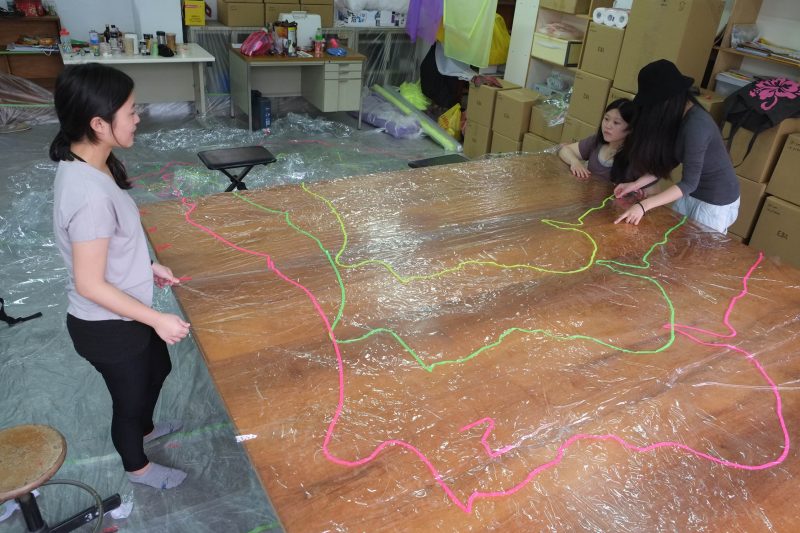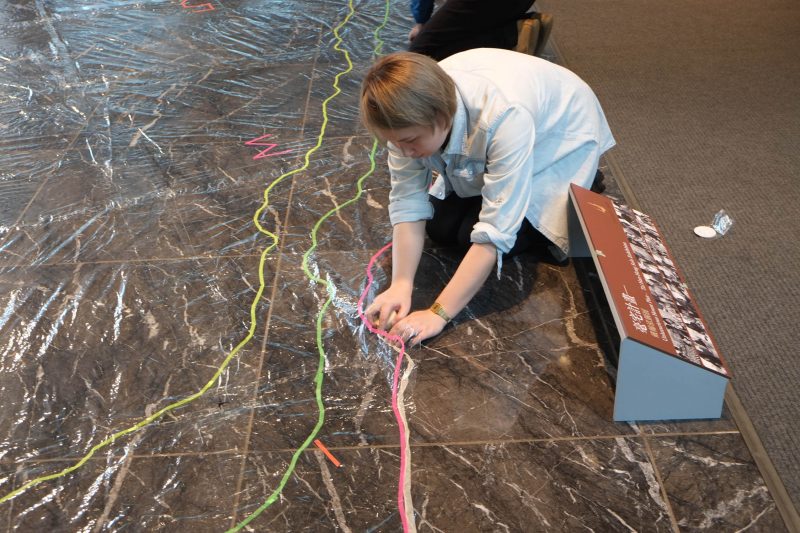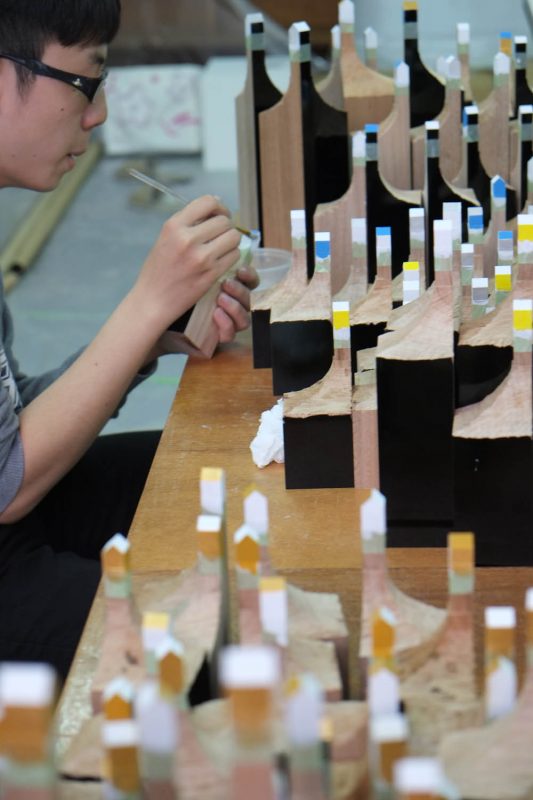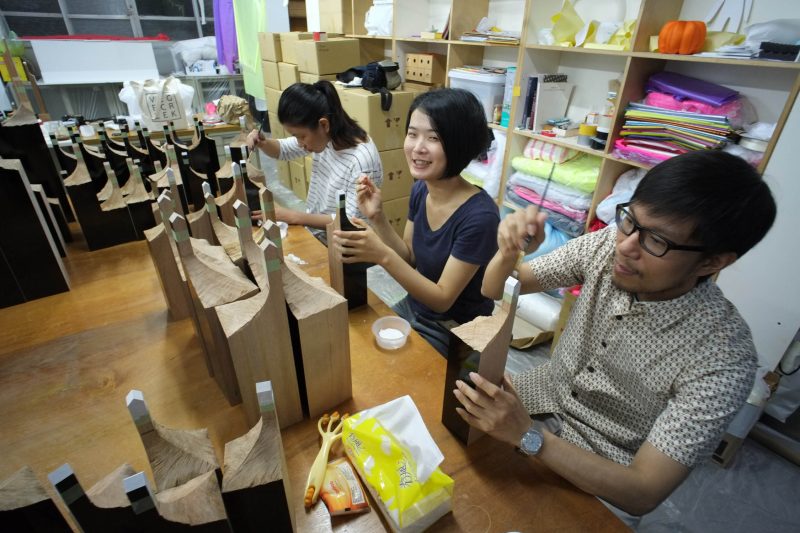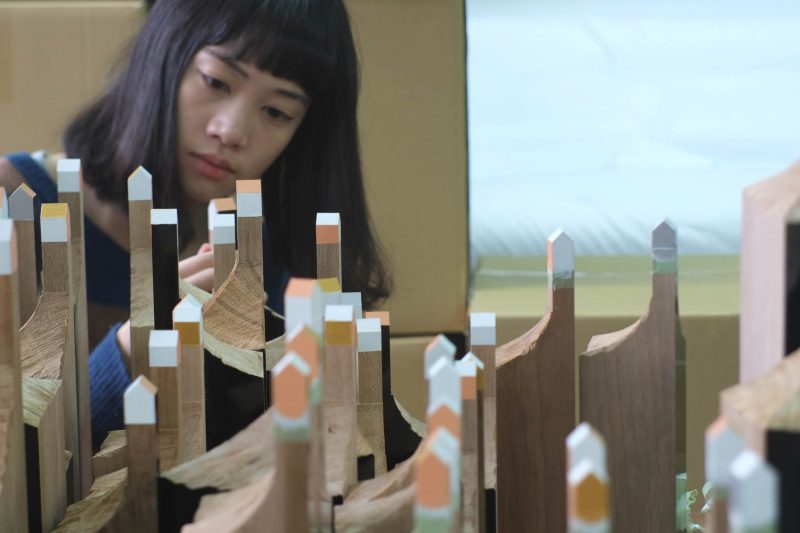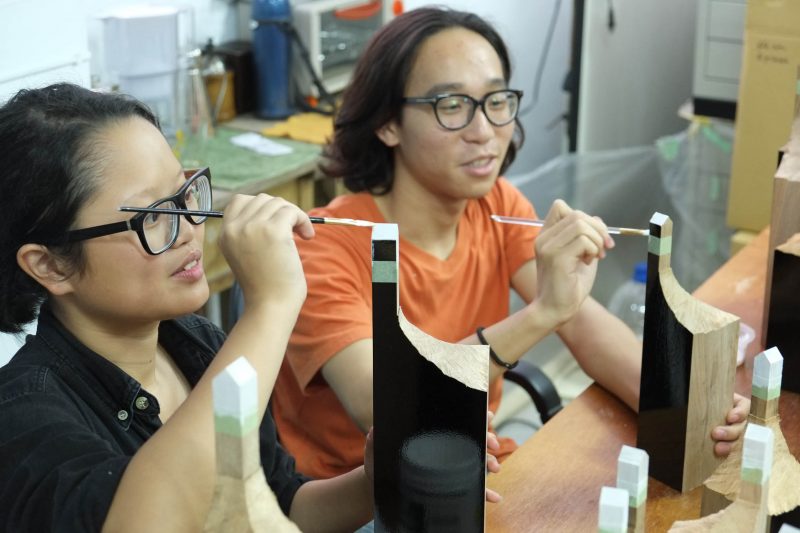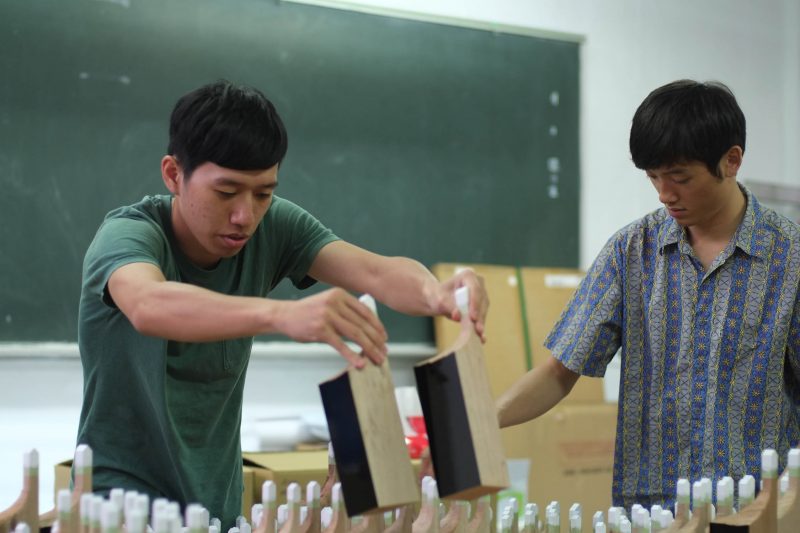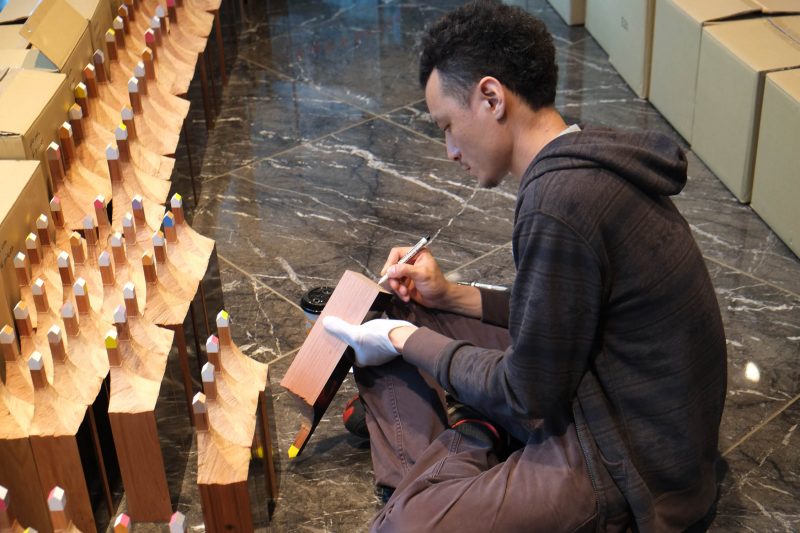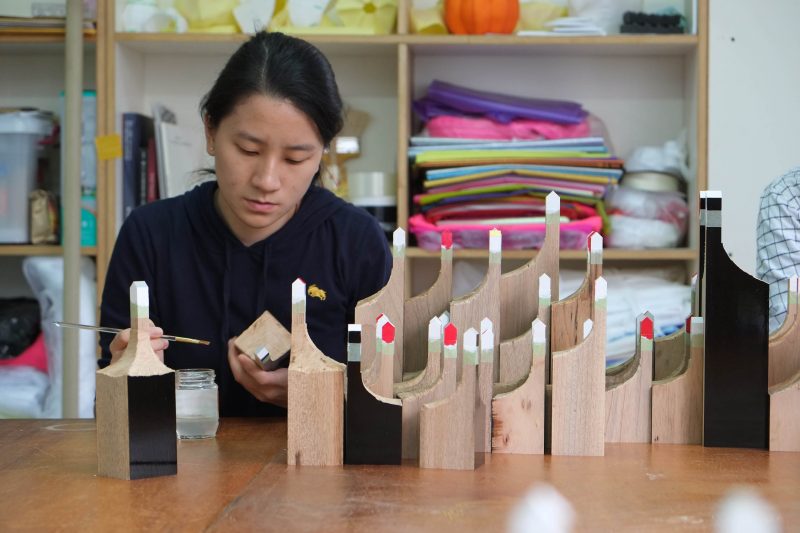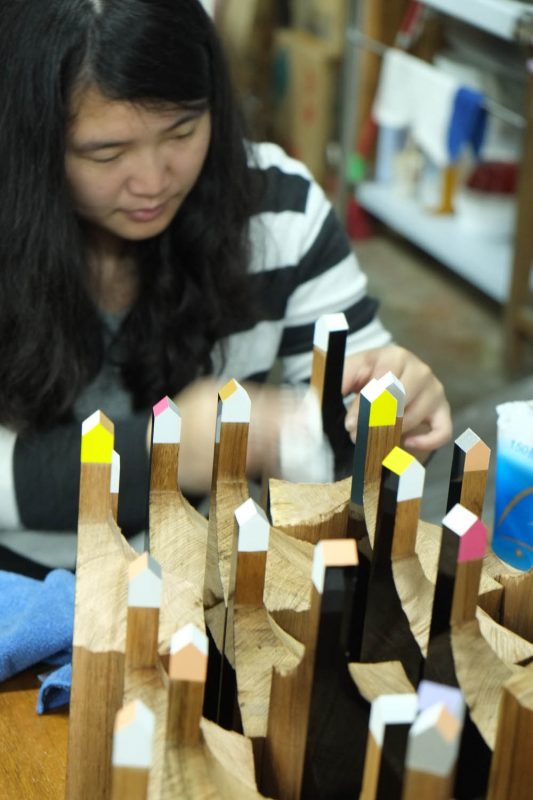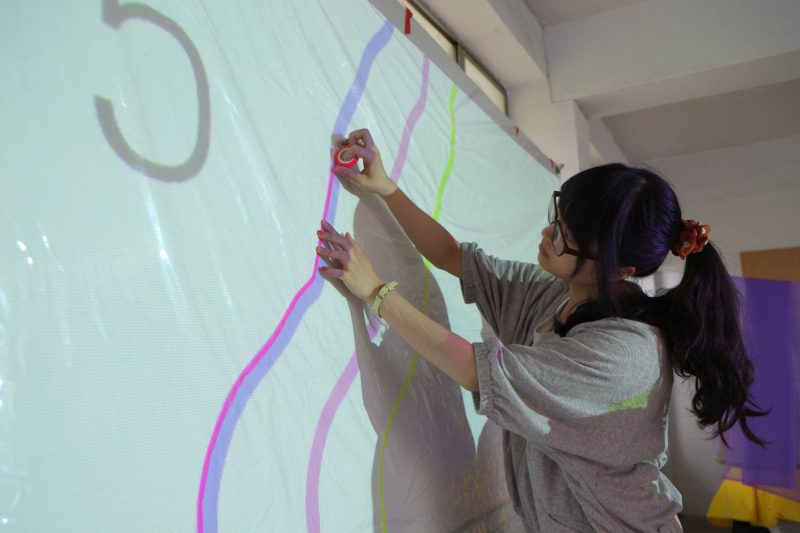作品概要:
以木塊削縮成更小尺寸的房子形狀,以對比我們所需要的和我們所想要擁有的。在首次展出地點台北仁愛圓環的豪宅大樓裡象徵性的與志工蓋下一棟棟的小毫宅,並且排列成台灣的形狀以凸顯其為當時台灣最昂貴的土地。
關鍵字:物件、空間、雕塑、裝置
參與志工群像
毫宅計畫 創作自述
這是與一群志工們在台灣最昂貴的土地上蓋出一棟棟小房子的計畫,在豪宅裡蓋毫宅以明志,希望藉由此計畫喚起一些什麼。
毫宅計畫中的作品單元是由木材角料急縮削細成更小尺寸的房子所構成,它反映出我五年前從南部鄉間到台北來,從偌大的工作生活空間急速縮減成狹小的現狀,但卻也更清楚了滿足生活需求的空間或許不需要太大的事實,也是對如何充分運用手頭上僅有資源的一種挑戰。
計畫一開始是從單件的雕塑出發,然後逐漸發展到大型裝置上的,我在第一件此計畫的雕塑作品完成時,曾寫道:
屋宅之大小永遠在我們心裡。
作品的發想正是來自我小小的工作室,我稱之為毫宅的工作室。
「毫」宅有兩個指涉,一個是相對於「豪」宅的一種反思、一種反動,另一個是以小喻大,像槓桿原理,從小的地方出發,卻產生極大的力量。
它提供一種限制中的滿足,細微總藏存於習見之中。我們的外在正以各種方式集結成一龐然大物,相對於內在所佔據的反而是想像不到的微小。 從南到北我經歷了一些空間限制的問題,我常想如果全台灣都有毫宅計畫所觸及的精神和概念就好了,大家可以用自己或多或少的資源,更深刻的體會生活、生命的本質。謹以此作品獻給那些資源條件比我豐富、能力比我好的朋友們,不是要大家都住進小房子裡面,而是希望你們能更妥善運用手上的資源,做一些我所做不到的事情。如果您已經在做,非常感恩的請您繼續保持。
特別感謝對此展協助或參與的各位:
王德瑜、袁廣鳴、吳季璁、陳浚豪、黃郁仁、陳維峰、何仲昌、瑪麗卡.康斯坦丁諾、李育瑄、周慧紅、呂季璇、邱薏璇、楊傑懷、林永淇、許筑鈞、李瑜雯、薛元皓、簡誌忠、翁羽汝、劉文琦、吳挺嘉、童怡靜、阮心慈、陳韋綸、段俐岑、呂佳縉、單任捷、洪維均、徐之陽、曾彥慈、張哲軒、台新銀行文化藝術基金會、關渡美術館。
木
許多朋友對我作品中使用的木材種類感到興趣,總想問問是什麼種類的木材,在此我想說:如果你期待的是一些名貴的木材樹種,可能要令你失望了,我所使用的僅僅只是在木材行中我可以取得的、當下供給平民百姓所使用的國民家具用材,是進口的實木木材,產地來源不一。我特意在作品的材質說明中只寫下「木」來強調運用的材料本質而非材料本身的價值。對材料本身而言,去承載我所賦予它的藝術價值的能力上,已非常足夠。
台灣的知名木材的確是世界上最好的材料之一,但對我而言,從政府禁採台灣的原木林之後,它便不再代表台灣了,一方面是我們尚不知如何永續經營我們的森林讓它生生不息,另一方面我認為,真正的台灣精神正是有什麼用什麼,當我們只能取得某些資源時,我們應當思考如何去賦予新價值,而不是回頭去強求使用某種材料、去依靠材料本身的價值。
台灣的木材如同台灣的一切一樣是我的至愛,對我而言已是一種象徵,我更想見到它們重新回到台灣森林中聳立著,而不是在我的作品中。我仍會在某些機緣如友人的贈與、或從某些舊家具門窗中拆解獲得它,但運用這些材料對我而言不是一種常態,更不是用來強調我的作品概念那種似是而非的方法,如果有天我強調運用名貴的木材來創作,那也一定是要去討論價值觀的問題。
相關連結:
台新銀行文化藝術基金會官方網頁展覽訊息
Facebook展覽活動網頁
ARTalks 藝術動態展覽訊息
評論 | 豪與毫:在資本的切分之間 文 / 陳維峰
新聞報導 | 2014年4月展覽地點仁愛圓環附近房價一坪超過500萬
Statement
This began as a single piece of sculpture which gradually developed into a large-scale installation. When the first sculpture was completed, I wrote:
Size of Dwelling is forever in our minds.
The idea of the work came from my small studio which I call my unluxurious house.
The unluxurious house references two points: on one hand, as reflections… reactionary thoughts on indulgence and magnificence; on the other, as a metaphor for the lever principle to which Archimedes stated "Give me a place to stand, and I shall move the Earth with it."
One must look at limitations from a positive perspective. If simplicity, propriety and subtlety are used as objectives then the balance between wants and needs could be readily bridged.
It was from these musings that I conceptualized the: Unluxurious house plan. The idea is to build many small houses on Taiwan’s most expensive land. This installation was executed with the help of some volunteers.
The individual pieces were constructed by cutting the wooden beams into thinner dimensions, until I was able to shrink it into smaller houses. To a certain degree, it depicts how my life evolved since five years ago: from a village south of Taiwan to Taipei… from a huge working and living space, rapidly reduced into a small one. More importantly, it represents my realization that living a resplendent life does not require that much space. The challenge is how to manage what is on hand and be gratified with its usage.
From south to north Taiwan, I encountered various issues concerning space limitations. I wish that the spirit and concept evoked in this plan can be an actuality for Taiwan. In this way, we can make full use of what we have (however bountiful or meager the resources may be) and in the process profoundly experience life’s essence.
To build unluxurious houses in well-appointed areas should be viewed as a paradigm shift and an aspirational notion.
I would like to dedicate this work to those who have the means, networks and skills to make better use of what you have and be of service to others. For those who are already on this direction, I am grateful… please continue on this path less travelled.
I would like to extend my deepest thanks for the assistance and participation in this exhibition to:
Wang Te-Yu, Yuan Goang-Ming, Wu Chi-Tsung, Chen Chun-Hao, Huang Yu-Jin, Chen Wei-feng, Ho Chung-Chang, Marika Constantino, Lee Yu Hsuan, Chou Huei Hung, Lu Chi Hsuan, Chiu Yi Hsuan, Yang Chieh Huai, Lin Yong Ci, Hsu Chu Chun, Li Yu wen, Hsueh Yuan Hao, Chien Chih Chung, Weng Yu Ju , Liu Wen Chi, Wu Ting Chia, Tung Yi Ching, Juan Hsin Tzu, Wei-lun Chen, Duan Li Tsen, Lu Chia Chin, Shan Jen Chieh, Hong Wei Chun, Hsu Chih Yang, Tseng Yen Tzu, Chang Tze Hsuan, Taishin Bank Foundation for Arts and Culture, Kuandu Museum of Fine Arts.
Wood
Friends would often ask what kind of wood I make use of; there has always been a curiosity in the type of wood in my works. Unfortunately, if you are expecting some valuable timber species, you will be disappointed. I utilize what I can get in the wood shop, what is readily available for civilians and what is usually used to make wooden furniture. These are imported timber that are of mixed origins. I specifically indicate the medium of my works as "wood" to emphasize its material nature rather than how it is regarded. The materiality of the medium to uphold the artistic value assigned to it is more than adequate.
Indeed, Taiwan’s well-known timber is one of the best materials in the world. However, despite the government’s ban on logging, a lot of people still use the country’s wood supplies in order to represent Taiwan. It does not matter if this is acquired illegally or at highly prohibitive costs. Since there are still no definitive measures to perpetuate our forests, coupled with the fact that we are a small island, we may run out of these valuable assets soon, most especially if we are not vigilant. Therefore, Taiwan’s "spirit" should not be denoted through Taiwan’s wood… Taiwan’s real "spirit" should be characterized through reconstituting and skillfully utilizing the given resources (even if these are all importations).
Without a doubt, I favor Taiwan’s timber. However, it is more symbolic for me now. I would like to see it thriving and growing in our forests but not in my works. While I may still have some opportunity to acquire and use such precious wood by getting them as gifts from friends or by dismantling some old furniture, windows and doors, the use of particular species is not of utmost importance for my process or concepts. If there comes a point when I do make use of a special variety of timber, a discourse on its perceived value would certainly be part of the conceptualization.
Relative Links:
TaiShin official exhibition web page
Facebook event
ARTalks Radar
Criticism by Chen Wei Feng
